

| Trade log-in: | HERE | |
| Get password | Forgot password | ||

2015.3 | 2015.2 | 2015.1
2014.3 | 2014.2 | 2014.1 | 2013.3 | 2013.2 | 2013.1 | 2012.3 | 2012.2 | 2012.1
2011.3 | 2011.2 | 2011.1 | 2010.3 | 2010.2 | 2010.1 | 2009.3 | 2009.2 | 2009.1
2008.3 | 2008.2 | 2008.1 | 2007.3 | 2007.2 | 2007.1 | 2006.3 | 2006.2 | 2006.1
2005 | 2004 | 2003 | 2002 | 2001 | 2000
In this edition of our newsletter we offer, amongst other things, three reprints, including the following by Kipling in which he likens the English language (and its squandering) to precious gemstones.
T H E B I R T H R I G H T
The miracle of our land’s speech—so known
And long received, none marvel when ’tis shown!
We have such wealth as Rome at her most pride
Had not or (having) scattered not so wide;
Nor with such arrant prodigality
Beneath her any pagan’s foot let lie...
Lo! Diamond that cost some half their days
To find and t’other half to bring to blaze
Rubies of every heat, wherethrough we scan
The fiercer and more fiery heart of man
Emerald that with the uplifted billow vies.
And Sapphires evening remembered skies
Pearl perfect, as immortal tears must show.
Bred, in deep waters, of a piercing woe;
And tender Turkis, so with charms y-writ.
Of woven gold, Time dares not bite on it.
Thereafter, in all manners worked and set.
Jade, coral, amber, crystal, ivories, jet—
Showing no more than various fancies, yet
Each a Life’s token or Love’s amulet...
Which things, through timeless arrogance of use.
We neither guard nor garner, but abuse;
So that our scholars—nay, our children—fling
In sport or jest treasure to arm a King;
And the gross crowd, at feast or market, hold
Traffic perforce with dust of gems and gold!
—Rudyard Kipling, from Debits and Credits, 1919–1923
After the holidays, we’re looking forward to the world’s greatest gem and mineral show in February. One-stop general information about individual shows can be obtained from the Tucson EZ-Guide.
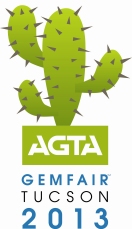 |
Pala International will be represented in Tucson as follows. We look forward to seeing our many friends there. Visit the Pala International Show Schedule for future events.
Pala joins nearly 100 exhibitors for this annual extravaganza.
Event: AGTA GemFair
When: February 5–10, 2013
Where: Tucson Convention Center
Pala International Booth: 1016
The event website now features an interactive floorplan allowing you to see who is exhibiting by area of the convention center.
More than forty free seminars are offered by notables in the world of gemstones and pearls.
Pala International’s Bill Larson will speak on the topic “Back to Burma” on Wednesday, February 6, from 1:00 to 2:00 p.m. in the Mohave Room.
Pala International and two dozen other world-class mineral dealers shack up at a Sonoran Desert resort.
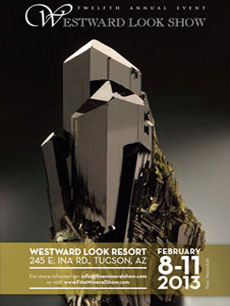 |
Event: 12th Annual Westward Look Mineral Show
When: February 8–11, 2013
Where: Westward Look Resort
Pala International Suite: 224
See Pala International’s page on the Westward Look Show site. See also this dealer map.
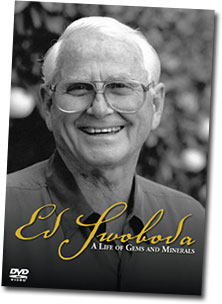 |
| Ed Swoboda was this year’s Sunday evening presenter and the event was captured by BlueCap Productions. |
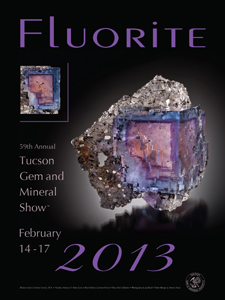 |
TGMS is the largest gem and mineral show in the country. This year’s theme is “Fluorite, Colors of the Rainbow.”
Event: 59th Annual Tucson Gem and Mineral Show
When: February 14–17, 2013
Where: Tucson Convention Center
Pala International Booth: Aisle 5 East
[back to top]
Many shows will offer their own shuttles. View your transit and parking options here. [back to top]
The Glenn and Martha Vargas Gem and Mineral Collection at the University of Texas is available for virtual browsing. The online database contains
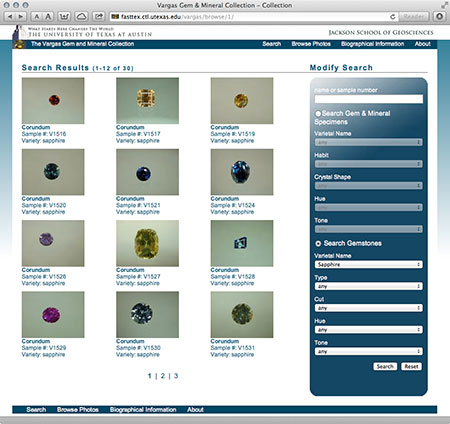 |
| Screenshots showing one of three pages of results for “sapphire,” above, and detail below. |
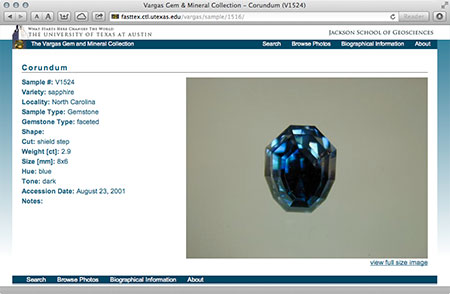 |
According to the collection’s website, the late Glenn and Martha Vargas taught faceting, lapidary and gemology at the University’s Department of Geological Sciences for 24 years, from 1975 to 1999. The couple authored several editions of books titled Faceting for Amateurs, Diagrams for Faceting, and Descriptions of Gem Materials. In their teaching and writing they helped demystify the field of lapidary. Their careers as teachers, authors, equipment crafters, and mineral dealers began in the 1940s. The Vargases often visited the localities and markets from which their material came. The collection that bears their name is the result of 60 years of collecting beginning in the mid-1930s. [back to top]
The Vargas collection (above) was used in three apps that are available for iPhone, iPad and iPod Touch. While it would have been nice to have had the three folded into a single app, it still can be useful to access Gems and Minerals by Varietal, by Hue, and by Habit.
We downloaded “by Varietal,” which opens to a Categories alphabetical list (as shown below left). Tap on a varietal name and get a list of entries; for instance, Amethyst returns Cristobalite as well as Quartz. Tap on an entry to view its image and data (as shown below right). Entries for a given category can be browsed via index finger or a slideshow button.
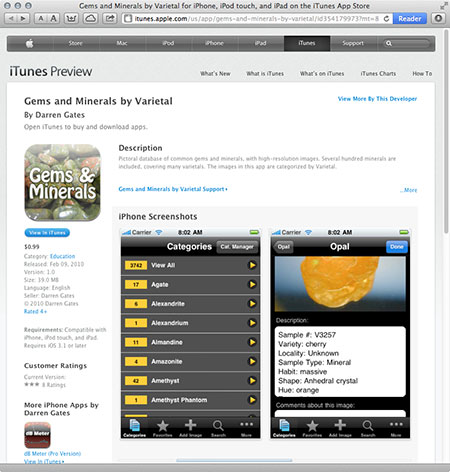 |
Note, however, for new entries that you add yourself, all of the data is entered by you into a single Description field; there are no pre-set fields of Sample #, Variety, Locality, etc., to fill in—only Comments, Title, Description and Category. If no comment, description or image is entered, these fields do not display.
Each entry can be edited, including removal. Thus, the app’s real potential is not necessarily for the student, but for the collector. We didn’t try, but presumably you could wipe out the database (a tedious task, granted, for 3,744 entries that come with the app) and add in your own pieces. Using your device’s camera, you can easily add a single image to a given entry. You can assign a secondary category, too. When the tweaking is done, you can email the image and data to friends and/or colleagues.
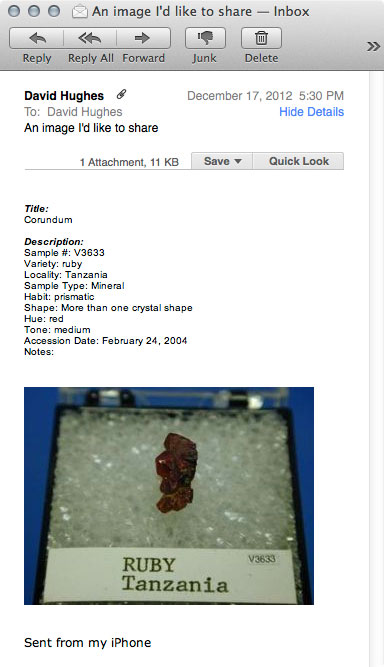 |
The links above provide info on all the capabilities and customizations. One more feature worth mentioning is obtaining a random mineral by shaking your phone.
Two caveats. You won’t be seeing images of the lovely faceted stones from the Vargas Collection pictured above. The app contains images mainly of small crystals. And 2,689 of the entries are to be found in the “Other” category, so using the Search function is advised. [back to top]
Blue and yellow and orange—Oh my! This month we feature a melange of sapphires. Sapphires are found in all colors of the rainbow and many mixtures in between.
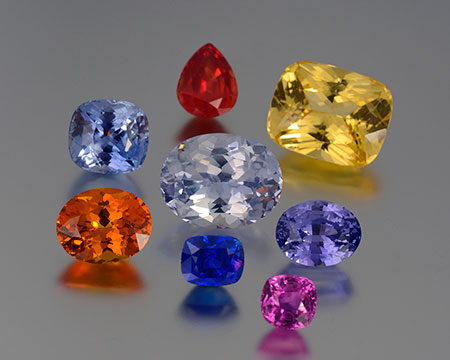 |
| Click to enlarge. (Photo: Mia Dixon) |
From the common ruby-red and sapphire-blue, to the more unusual purple color-change and blended orange and pink, sapphires fill the color wheel with endless possibilities. Clockwise from top: 5.66-carat natural pear-shape orange-red from Malawi (Inv. #20451), 25.51-carat fancy canary-yellow in a brilliant cushion cut (#20615), 10.08-carat violet-purple oval with lots of life (#20452), 4.03-carat purply pink one from Madagascar (#14626), 4.77-carat fine natural Sri Lankan blue (#20081), unusual 10.09-carat pumpkin orange (#20356), 11.5-carat pastel violet-blue (#19503). Center: 21.36-carat icy-blue oval brilliant-cut from Sri Lanka (#20453).
Interested? Call (phone numbers below) or email us to inquire. [back to top]
…as in Cabernet. Coghlan Vineyard & Jewelers, of Los Olivos, California, has released a new addition to its line of fine wines: Estate 2010 Late Harvest Cabernet. (We saw it on Facebook.) Each Coghlan wine is named for a gemstone, and this release is no exception. “Ruby” features a Mogok specimen gifted to the Coghlans by the Larsons of Pala International.
We’re a fan of late harvest reds and can’t wait to sample what the award-winning Coghlans have to offer.
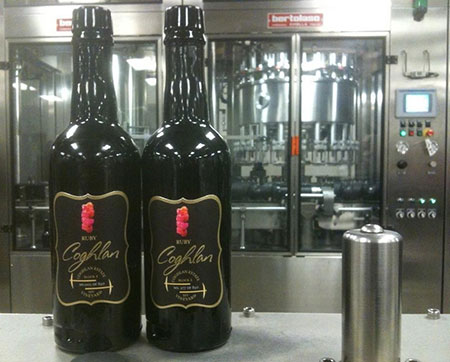 |
| Click to enlarge. (Photo: Coghlan Vineyard & Jewelers) |
[back to top]
In May, we tempted you with reports on island-nation corundum finds in Sri Lanka and Madagascar. Vincent Pardieu, of the GIA Laboratory in Bangkok, and his coauthors produced an 82-page study of the Sri Lanka find, but the larger work on the Madagascar discovery was yet to come. As usual, the wait was worth it.
“Ruby and Sapphire Rush Near Didy, Madagascar (April–June 2012)” is an 84-page report by Pardieu and Nirina Rakotosaona (Société Minière du Cap, Madagascar).
But before you tackle that impressive study, you’ll want the informal backstory on how Pardieu came to make the trip to Madagascar. It seems he was told about the new find, near Didy in the northeastern part of the island, only two weeks before he and travel-pal Lou Pierre Bryl were to be best men in the wedding of co-pal Jean Baptiste Senoble. To flee, or not to flee, that is the question…. (Spoiler alert: They did.) In the course of telling this tale, Pardieu bestows upon us his “Basic Rules of Field Gemology,” using the present prospective expedition as a case in point.
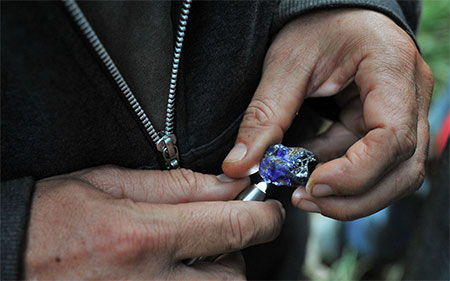 |
| A large blue sapphire seen in Didy. (Photo by Vincent Pardieu. © GIA) |
In April 2012, fine blue sapphires turned up in a local market in the area of Didy. That same month, Pardieu and his team arrived there, finding that the deposit was in a rainforest corridor between two national parks. The “Ruby and Sapphire Rush” study begins with a look at the area’s biodiversity—including a rare lemur—that is threatened not just by mining (including gold), but also logging and agricultural clearing. The report then looks at the history of corundum mining in the various localities of the area, and also the geology of the island, before focusing on the new discovery, which brought thousands of miners and hundreds of buyers to the region.
Ironically, by the time Pardieu’s team arrived in Didy, the flow of stones into the markets had dwindled due to the presence of soldiers at the mines, intimidating inexperienced locals. (This changed, however, when thousands of veteran miners flooded the area.) Not long after their arrival, they were told by the local security forces that foreigners would have to return to the district capital by noon the next day. Fortunately Pardieu’s coauthor, Rakotosaona, is a Malagasy miner, and was able to visit the mining area with Pardieu’s camera and other nationals on the team. The photos of the mining capture immaculately the activity of miners who, by their rush to Didy, had made a ghost town of Ilakaka, the town in the southwest that had its own boom a decade ago. One striking photo shows sapphire sieving on the right of the frame, gold panning a few feet away on the left.
Back in the capital the foreign cohort used its connections with Sri Lankan dealers to see what was in the market. “Ruby and Sapphire Rush” spends several pages showing-and-telling about the mostly blue sapphires they came across. And by spring’s end in June it all was over. Or was it? (Two other Madagascar sapphire localities are reminders that the island has much to offer.)
The study spends two dozen pages taking us through the inner world of inclusions and enhancements in sapphire and ruby crystals from Didy. The report is rounded out by more than two pages of local and international press coverage of the Didy discovery.
It’s worth recounting here that in the preface to his “Basic Rules of Field Gemology” Pardieu suggests that if you accept the fact that “on each expedition you have [a] 1% chance not to return” due to myriad dangers, you’ll have only a 36.6% chance of survival through the end of expedition No. 100. We’re grateful to Pardieu, his travel pals and peers, his predecessors and successors, for their vim and vigor and vision in digging deeper and deeper. [back to top]
Two years ago, we reported on a study of mining on the island of Zabargad—Arabic for peridot—in the Red Sea. This month we’re pleased to offer a reprint of that article, by James Harrell (University of Toledo, USA) and Elizabeth Bloxam (London University College, UK), which originally appeared in MINERVA magazine. (Last month we pointed to Dr. Harrell’s article “Gems from the Red Land.”)
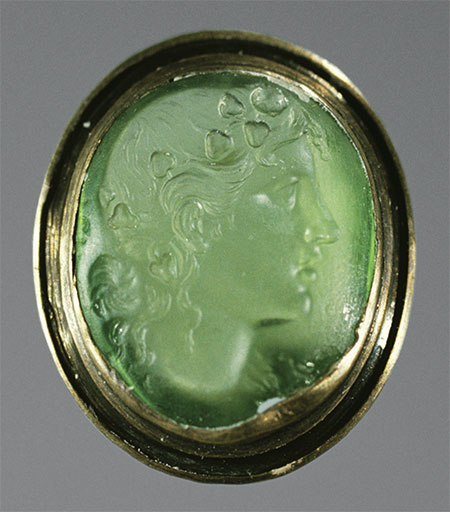 |
| Peridot intaglio of a maenad wearing a wreath of vine leaves in her hair and a bunch of grapes over her forehead. Carved for a 2nd-century BC finger ring but now in a modern setting. Stone c. 18 x 16 x 5mm. Ashmolean Museum acc. no. 1892.1497. Courtesy of the Ashmolean Museum, University of Oxford. (Photo: Lisbet Thoresen) |
The island is the only known ancient known source of peridot, which was said by one Hellenistic historian to be best found on the island just after sunset, hence the “evening emeralds” of the study’s title. Visiting Europeans in the 18th and 19th centuries actually mistook the stones for emerald. The authors cite several Greek, Roman, Arab and European references to the island and its production of the gemstone.
Dr. Harrell has spent the past 23 years conducting a field survey of ancient Egyptian quarries and mines, including those on Zabargad, also known as St. John’s Island. The present study is essentially the first to identify or describe the Hellenistic-Roman peridot mine. The article is nicely illustrated with site and crystal images by Dr. Harrell along with finished gemstone images by Lisbet Thoresen. Read “Egypt’s Evening Emeralds” here.
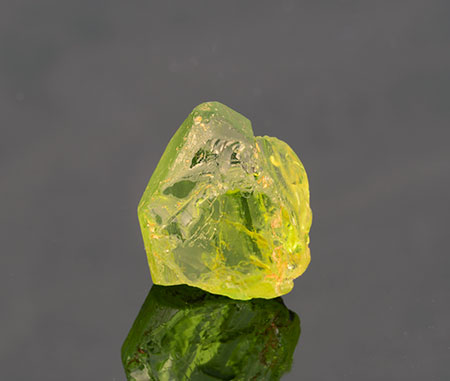 |
| Peridot crystal from Egypt, 15.21 ct, 1.64 x 1.44 x 0.76 cm. This crystal is destined to be faceted by Pala International. (Photo: Mia Dixon) |
[back to top]
SSEF, the Swiss Gemmological Institute, has posted its research publications online. The publications fall into four categories: colored gemstones (177 articles), diamonds (43), methods (58) and pearls (45). Some of the articles are in languages other than English. A sampling:
Access the search engine here.
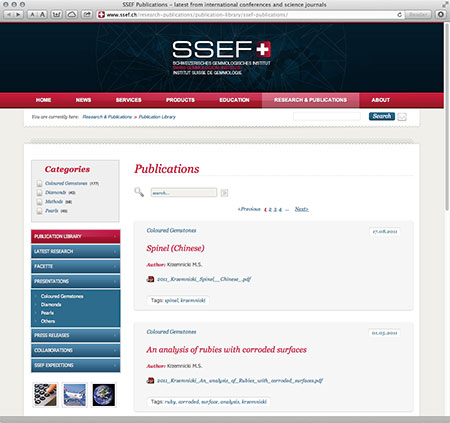 |
[back to top]
Richard W. Hughes, Wimon Manorotkul, their daughter Billie and Julie Poli traveled recently in Sri Lanka. They spent time in the mines, markets and byways of the country, cameras in hand. Amongst other places, the party visited mining at Bubaladaniya (near Ratnapura), Elahera (eastern Sri Lanka) and Meetiyagoda (southern Sri Lanka); and markets, cutting and treating at Ratnapura and nearby Nivithigala as well as Beruwela (southwest coast).
 |
| Juicy. Hosing down the illam (gem gravel) in Elahera, Sri Lanka. Note the recycled juice bottle nozzle. (Photo: Billie Hughes) |
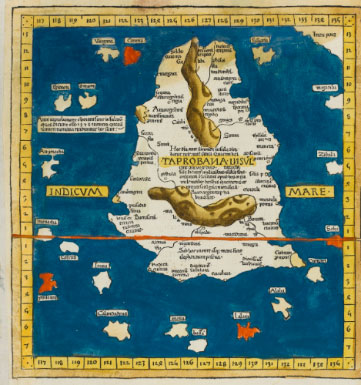 |
| Ceylon. A map of Sri Lanka, 1482, by Leinhart Holle. It fetched nearly £12,000 at Sotheby’s nearly twice its upper estimate. See detail here. |
[back to top]
In August 2009, Campbell Bridges, discoverer of the variety of grossular garnet known as tsavorite, was murdered at a time when he was challenging the illegal mining of the gemstone in Kenya. Perhaps the saddest aspect of Bridges’ death is the fact that he had been threatened previously by his attackers.
Three years after the murder, the Bridges survivors still are in want of justice and security, as is laid out in “Murder, Corruption and Greed,” an article on the background and status of the case, by Sherman Pike of the Jewelers Ethics Association. The aim of the article is to shed sunlight on the situation that, even now, remains tragic.
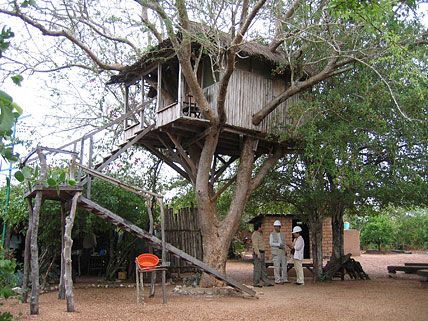 |
| And still it stings… The late Campbell Bridges’s tree house at the Scorpion Mine in the Taita Taveta District. (Photo courtesy International Colored Gemstone Association) |
[back to top]
Last week, the Bloomberg featured a 56-second streaming video of a large star sapphire hailing from Sri Lanka (pictured below). According to the video, the 1,395-carat cabochon carries a $2.78 million pricetag. Also mentioned in the piece is the “world’s largest blue sapphire,” a 17-kilo gemstone cut from a 42-kilo mother stone, the latter of which appears to be pictured in the video.
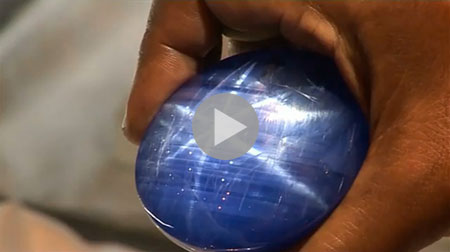 |
| This 1,395-carat star sapphire is featured in a Bloomberg streaming video. Click to view video. |
[back to top]
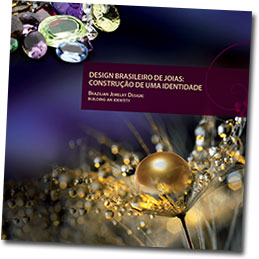 |
The Brazilian Institute of Gems and Precious Metals (IBGM) has issued an overview of contemporary jewelry designs, “Brazilian Jewelry Design: Building an Identity.”
The report includes winners of the 2012 IBGM Design Awards in the categories of Differentiated Cutting, Jewelry with Colored Gemstones and Gold Pearls, and Contemporary Poetics.
Also included are sections on Beauty and Goodness, Nature and Culture, and Contemporary Preciousness of Colored Gemstones. [back to top]
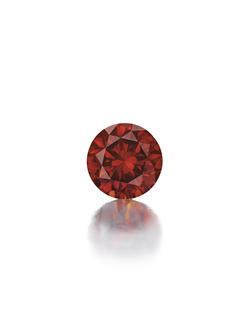 |
| This 3.15-carat reddish-orange diamond set a new record for world auction record for such a stone, as well as per-carat record. (Photo: Christie’s press release) |
Some news of note in the diamond world.
Laurence Graff obtained a 50-carat D-color potentially flawless colorless diamond from Christie’s on December 10 at the New York Magnificent Jewels sale. He knew the stone well: Christie’s had sold it to him for $4.2 million in 2005. The price had just about doubled in the meantime: $8.37 million. Graff said in a statement that this is the third time he has owned the diamond, according many reports, including JCK.
A highlight of the sale for colored stone lovers was the sale of the rare and beautiful reddish-orange diamond pictured at right. It is the largest such diamond ever graded by GIA and sold for $2.09 million—$666,200 per carat.
On December 7, Harry Winston announced that it would eventually spin off its retail enterprise from its mining division, but that would happen “in the fullness of time,” according to Toronto’s Globe and Mail. This follows an insider in October having claimed that Winston had tried to sell off its jewelry and watch business prior to the firm buying Canada’s Ekati diamond mine in November.
Last month, South African police arrested a man who they said swallowed 220 cut diamonds in order to smuggle them from the country, according to BBC. A body scan caught the caper. A similar attempt was made in March. [back to top]
 |
| Bite-sized? This 3.31-carat spinel from Burma has an AGL cert. Inv. #20466. (Photo: Mia Dixon) |
All the bits are bite-sized this month.
[back to top]
We featured these items earlier this month in our sibling newsletter, Pala Mineralis.
Following our feature last month of Czechoslovakian glass crystal models, and their inclusion in the Virtual Museum of the History of Mineralogy, Bill Larson brought out two sets of gemstone models and a set of gemstone specimens from Bohemia. Read more here.
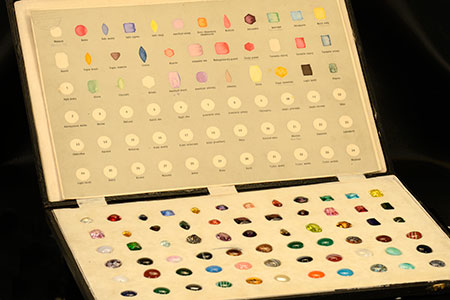 |
| According to the enclosed table, this set is from Rovensko Pod Troskami, Semily, Czechoslovakia, early 20th century. Seventy-two colored glass gemstone models (size ranging from 1.10 to 1.95 cm), attached hand-tinted legend, loose Tabulka (table, 47.5 x 31 cm) compiled by P. Homola, teacher training school in Turnov, in chamois-leather, linen lined inner lid and faux leather covered case (36.5 x 25 x 2.5 cm). (Photo: Mia Dixon) |
[back to top]
From Cannes to Munich to La Jolla, mineral crystals are gracing the display windows and cases of Chanel and J. Crew, courtesy Mia Dixon, Brice Gobin and Larsons Jeanne, Bill, and Will.
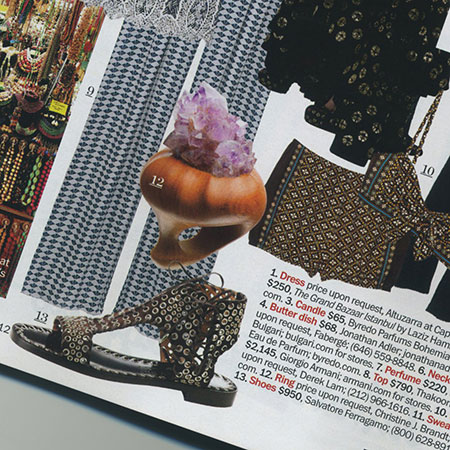 |
| Pala’s Mia Dixon spotted this ring by Christine J. Brandt in the magazine Marie Claire. |
See more images here. [back to top]
— End December Newsletter • Published 12/17/12 —
This edition of our newsletter comes to you on the eve of President Barack Obama’s historic trip to Burma and Cambodia. According to The New York Times, no sitting U.S. president has ever visited these countries. We also come to you just before Thanksgiving. We express our deepest thanks for your patronage. Thank you also to all who have contributed content to our newsletters. We wish everyone happy holidays.
A lovely collection of hand-cut glass crystal models came up for discussion this year at the Denver show. Pala International’s Bill Larson first viewed the set of models in the mid-1970s when it was acquired by Phil Gregory, miniature mineral collector extraoridinaire. Even after Gregory sold his famous mineral collection, the crystal models were never offered for sale. Until now.
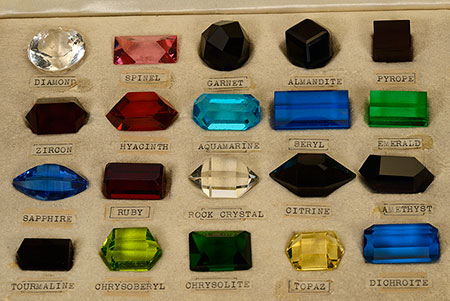 |
| Images of this collection of hand-cut crystal models now have a page in the Virtual Museum of the History of Mineralogy. The models range in size from 1.5 to 3.1 cm. The faux leather case (21.5 x 15.5 x 3.2 cm) is lined in chamois on the bottom, with a plush soft fabric inner lid. (Photos: Mia Dixon) |
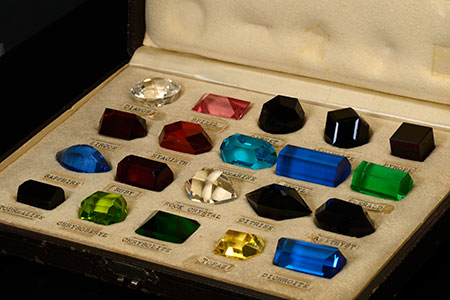 |
Phil Gregory is collecting again. He stopped by the Pala International room at the show in Denver and happened to mention that he still had the set of crystal models. He said he might just part with that collection. The following day, with fellow mineral collector George Holloway, a favorable arrangement was mutually accepted, and Bill Larson is now the proud owner of this great set.
The maker of the models is unknown, so we asked the experts for their opinions. Both R. C. Blankenhorn, Ph.D., proprietor of The Gemmary in Fallbrook, and Paul Tambuyser of the Virtual Museum of the History of Mineralogy, feel that the set is not as old as once thought, but likely dates from the late 19th century to the early 20th. Both also believe it was most likely made in Czechoslovakia. As to the maker, Dr. Blankenhorn opines that is probably Václav (Wenzel) Frič (1839–1916) who, according to Wendell Wilson, “opened his natural history business [in Prague] in 1862, supplying mineral, botanical and animal specimens to private collectors, museums and teaching institutions worldwide.” Dr. Blankenhorn told us:
These models look to be the same as the models sold by Krantz in their early 20th century catalogs, but the set size (20) is not one of the sizes sold by Krantz (the smallest Krantz sets were 18 and 24). Krantz probably contracted with Frič for their colored and colorless glass models. Unfortunately, I have never seen any literature on Frič.
We are grateful to these experts for sharing their thoughts. If any of our readers wish to weigh in, we welcome it.
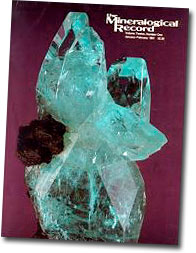 |
| Phil Gregory’s phosphophyllite graced the cover of the January–February 1981 Mineralogical Record. |
[back to top]
Pala International loves to have had the opportunity over the last two years to have floor space at the Munich Show. This year, Pala also contributed to the show’s themed exhibition, “African Secrets.” Several Pala people were caught in the camera lens of fellow Southern Californians Eloïse Gaillou and Alyssa Morgan, members of the Mineral Sciences staff of the Natural History Museum of Los Angeles County, who attended the show. Behind-the-scenes shots and more are included in Gaillou’s Minblog post.
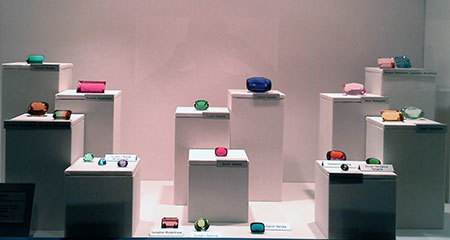 |
| Just one of many displays from the “African Secrets” exhibition. For great enlargements of these images, visit MinBlog. (Photos courtesy Eloïse Gaillou) |
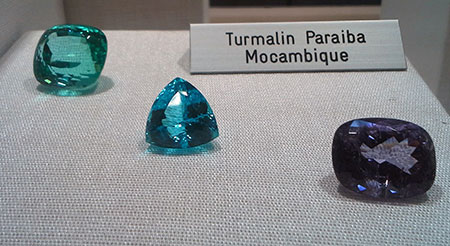 |
Gaillou also includes images from the Treasury of the Munich Residenz, which holds the collections of centuries-worth of Bavarian rulers. The Treasury houses over 1,250 works of art, including royal jewels, liturgical items, clocks and objets d’art.
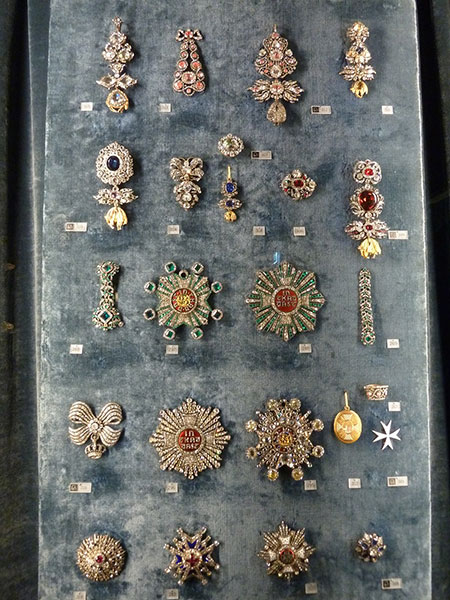 |
| Wall of Golden Fleece. Many of these insignias, displayed at the Treasury, will be familiar to our readers. In July 2010 we examined the relationship between the stone that would become the Hope Diamond and a ceremonial pendant for the Order of the Golden Fleece. (Photo courtesy Eloïse Galliou) |
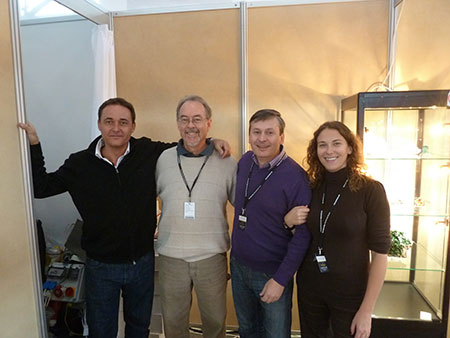 |
| Left to right, dealer Christophe Gobin, photographer Jeff Scovil, dealer Alain Martaud, and your host of her virtual tour on MinBlog, Eloïse Gaillou. (Photo courtesy Eloïse Gaillou) |
The photos below are included, with ten more, in “Munich 2012” on Palagems.com.
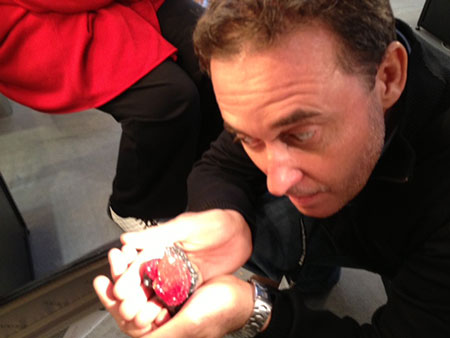 |
| Escargot mignon. Here’s Christophe Gobin again, holding “The Snail.” Rarely, in a photo, do you get a sense of scale for the little snail. (Photo: Bill Larson) |
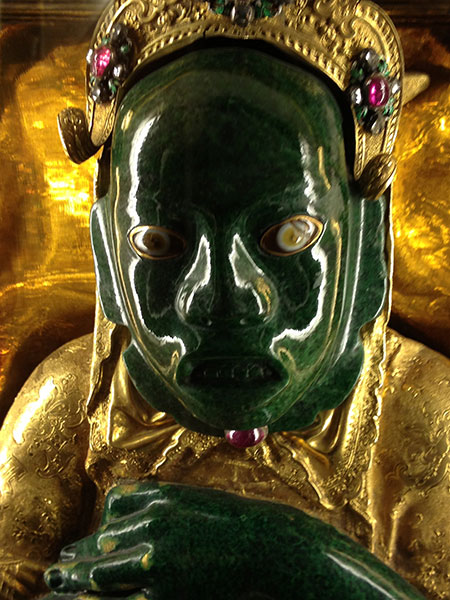 |
| “He what?!” Bill Larson, reacting to news that Christophe dropped “The Snail.” (Photo: Bill Larson) |
Will Larson was quoted in Süddeutsche Zeitung, Germany’s most popular national daily newspaper. We provide a rough translation of an excerpt below.
The darling of German windowsills, “The Snail” is an approximately fist-sized rhodochrosite, shaped like a black worm with a red “house.” “I like the shape,” says Will Larson, a young man dressed in a purple shirt, and as he says it, he shows almost childlike enthusiasm. Will’s father [Bill] said the specimen was discovered* from the South Africa N’Chwaning mine during manganese removal. The Austrian dealer and collector Rudolf Watzl estimates the value of the specimen at about ten million euros. [Implying that it is invaluable,] he says, “This is your possession, but not with money to offset,” looking longingly at the glittering red. These minerals show that, in the Larson home, value is put into curious shapes, such as Will’s “Mickey Mouse” and “deadmau5,” precious stones in orange [olmiite] and green [prehnite], which strikingly resemble their namesakes.
“The value of the pieces is not calculated in price,” says Will Larson, who works day-in-day-out with mineral specimens: “It is the love of their beauty.” And that is there to be seen—if the grandeur of the stones is reflected in the eyes of the beholder.
_______________
*The German-language version of the article states, inaccurately, that “The Snail” had been “smuggled” (geschmuggelt) from the mine.
[back to top]
This month we feature an exceptional imperial topaz from Ouro Preto, Brazil. We normally focus just on the loose gem, but this exquisite piece of jewelry just fell in our lap out of an estate collection. We couldn’t help but present the piece in all its glory, from the finely crafted platinum mounting to the fine white diamonds, all accentuating the sherry-colored jewel that is the centerpiece. This imperial not only has the golden hues but spills over into the the sherry and cherry spectrum, which defines it as one of the most sought-after colors. Since these unusual colors only really come from a small area in Brazil, production is limited and demand has always been strong, making it difficult for us to fill our clients’ needs. This is a great opportunity to pick up one of Brazil’s little treasures.
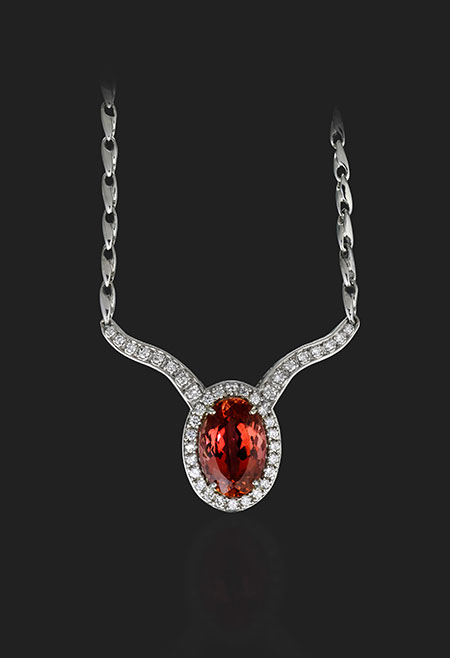 |
| Imperial topaz necklace. Topaz 17.54 carats, 19.08 x 12.88 x 8.99 mm, GIA certified. Diamonds 2.20 carats, VS clarity, F color. Platinum mounting. Price on request. (Photo: Orassa Weldon) |
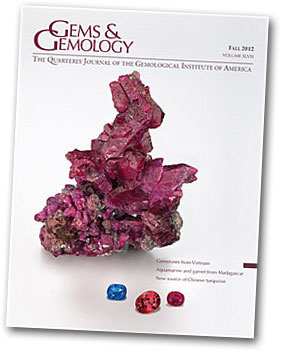 |
Pala International is cover star of the current Gems & Gemology journal, issued last month by GIA. The specimen and stones, photographed by Robert Weldon, herald the featured article, “Gemstones from Vietnam: An Update,” by Dr. Le Thi-Thu Huong and a team of coauthors. The article discusses the country’s major gemstones, highlighting recent production and new finds. New information is included on the gemological properties and chemical composition of ruby, sapphire, spinel, tourmaline, garnet and peridot from the major localities. Other stones also are reviewed.
The luscious jumble of a ruby specimen pictured above is from Luc Yen, in northeastern Vietnam. It’s in the collection of Bill Larson. Luc Yen produces a host of gemstones and minerals, as listed in this Mindat entry.
The three faceted gemstones, from Pala International, also hail from northern Vietnam. Left to right, they are a 1.97-carat blue spinel, a 5.07-carat red spinel, and a 2.27-carat ruby.
Will Larson shares a remarkable memory regarding acquisition of the specimen.
When I was 12 years old my father took me on a Southeast Asia tour visiting Burma, Thailand and Vietnam. Vietnam was our last stop and was an amazing experience. I remember flying into Hanoi, and my father pointed out the Russian-made planes, which looked rusty and old. He said we will not fly on those because of safety issues, and sure enough a few days later one crashed trying to land at Siem Reap Airport in Cambodia. After clearing customs we arrived at the house of my father’s contact, Sun Ta. The architecture is different, as they are very narrow but tall, three-story homes. What I probably remember most was that Sun Ta had a side business making T-shirts, like the ones you see at the store for fifteen dollars with cheap print on them. It was cool, I thought, to make your own T-shirt and being at the age of 12 I was fascinated with how it all worked. I played around and I was allowed to stamp my own shirt that I still have to this day (although a little small). We checked into our hotel and then got some shut-eye because we had to leave late that night to make it to the Luc Yen Women’s Market by 5:30 a.m. when it opened. The trip was about 225 km on many dirt roads, today an estimated 3 hours and 32 minutes on Google Maps, but on our trip took us closer to 7 hours. The trip was bumpy and I was so sleepy it was painful. The guy in the back of the Mitsubishi Pajero was riding in the trunk clutching an AK-47; I’m sure it was even more uncomfortable for him.
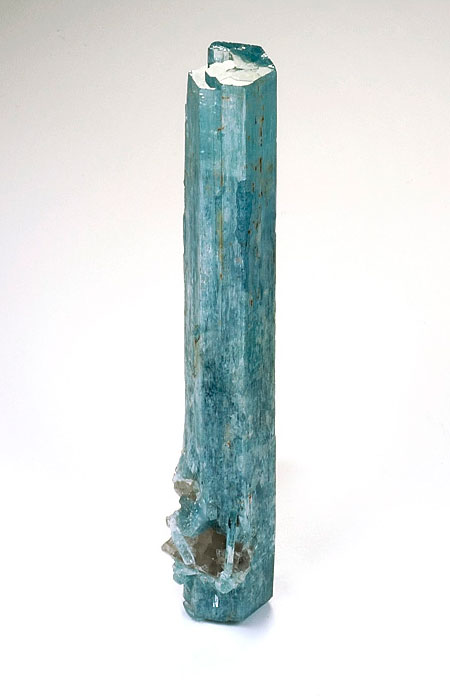 |
| Aquamarine from the collection of Will Larson, acquired when he was twelve years old. (Photo: Wimon Manorotkul) |
I couldn’t wake up for the Women’s Market, as I had passed out in the back seat of the car, but at 6:30 the Men’s Market opened and my dad came back just before to wake me up and show me what he had purchased at the Women’s Market. I was able to purchase a few things: small spinels and tourmalines including an aquamarine crystal I still own. As we walked around the village the people of this area had not seen a Caucasian child before and found me very curious. At one point in the mid-afternoon I had about 300 people following me just to get a closer look and of course they loved to touch my hair, as it was good luck. I was also asked when I would marry by many of the young girls who seemed to be around my age and already had a two-year-old child. Farming villages are very different in Vietnam than here; it was quite a culture shock back then. I started thinking about what I should do for marriage and when I should have children. Ha! I was a cute and confused twelve-year-old. We stayed for just part of the day, as we had an appointment with the doctor on the return back to Hanoi that evening.
 |
| Red hot. Intense natural orangy-red spinel from Vietnam, 1.2 ct, Inventory #15678. (Photo: Wimon Manorotkul) |
Our trip back was full of adventure. The first thing we saw was a small open-pit in the middle of a rice paddy. They were in fact digging for gems and allowed my father and me to see what they were doing. I found a few small bits of ruby in the stream that they let me keep. The farmers who were digging brought us a few pieces they had found earlier that had promoted the digging. It was unfortunately nothing too exciting, but there was a cute little spinel. Regrettably due to some circumstances they were unable to sell us the piece, so we moved on to continue our journey.
We stopped off to visit a doctor that, rumor had it, owned a few great ruby crystals from Luc Yen. We were greeted warmly and treated to some very good hot tea. The doctor then brought out his collection of ruby and it was amazing because we had never seen this kind of quality before. Out of everything we saw in the Women’s and Men’s markets, his collection was far better. The problem was he was not really interested in selling any of the pieces from his collection piece by piece, as he loved them all. Ruby is very good luck in Vietnamese culture. He did tell us that if he was able to get enough for these then he could perhaps purchase the condo he wanted, and this was in 1997 so condo prices were about the value of his rubies. So he said he would maybe work it out. We of course wanted to buy it all but didn’t have enough money on us. As we negotiated and negotiated we were forced to call my mother at midnight in the U.S. so that we could do a money transfer. Unfortunately we found out there was really no way of transferring the money to Vietnam without using a Visa card that had heavy fees associated with it, but it would be done quickly. Luckily the doctor was able to negotiate a better price on the condominium and this allowed him to reduce the price of his collection so we could then finalize the deal. One of the crystals from that deal is on the cover of Gems & Gemology.
 |
| Cool blue. How about a cobalt blue spinel from Vietnam? It’s unenhanced, 1.26 ct, Inventory #20502. (Photo: Mia Dixon) |
It was a long, bouncy, and slow ride back to Hanoi and we were all exhausted. It was about 6 p.m. when it started to get dark and I was nodding off trying to get some sleep. I remember waking up to a large bounce, undoubtedly caused by a big pothole. Soon after, we drove over train tracks when a loud bang and then shouting occurred. A motorcycle had hit us from behind and the driver appeared to be quite drunk. Our contact told us to keep our heads down and to not show anyone we were foreigners. Being twelve years old I just couldn’t help myself and I popped my head up as far as I dared to sneak a look. I remember watching our driver get out of the car, walking to the back by the motorcycle and was very calm as he approached the motorcyclist. In my memory I imagine him talking off aviator sunglasses, but I know he wasn’t wearing them since it was too dark, but what he did do was take out something from his pocket and flash it real quietly. I never got to see what it was, but as soon as it was out the driver of the motorcycle turned around and ran away, leaving behind his motorcycle and the crowd that had now grown around the drama. Later I found out he was working for the CID (central intelligence agency) in Vietnam and the guy who hit us obviously didn’t want to mess with that. After that our journey back to Hanoi continued without any problems. A few days later we headed home with the Southeast Asia trip concluded.
This same Fall edition of Gems & Gemology contains an in-depth gemological investigation of a faceted nano-polycrystalline diamond (NPD), by Elise Skalwold, a contributor to our pages, and coauthors Nathan Renfro, James E. Shigley and Christopher M. Breeding. This is a relatively new type of synthetic that has extraordinary properties—namely high transparency and superior toughness. Elise first introduced NPD to the gemology world though an article published in the earlier Summer issue of G&G, “Nano-polycrystalline diamond sphere: a gemologist’s perspective.” Tying both these articles together, in the latest GemGuide (Gem Market News), Elise provides an experiential account of this unique opportunity to study both the sphere and faceted gem. (The GemGuide is a publication dedicated to keeping subscribers up-to-date with the latest pricing and developments in the world of colored stones and diamonds. Pala International’s Bill Larson and Josh Hall are both members of its advisory board).
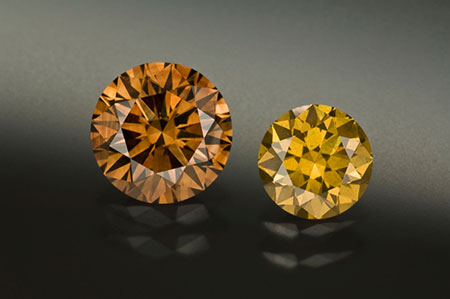 |
| From The GemGuide. Richard W. Wise kindly provided this spectacular 1.66-carat fancy color natural diamond (left) to contrast with the faceted nano-polycrystalline synthetic diamond seen at right. The 0.88-carat NPD gem was provided for study by the technology’s inventor, Dr. Tetsuo Irifune, Director, Geodynamics Research Center, Ehime University. (Photo: Jeff Scovil; commissioned by E. A. Skalwold) |
Of this series of articles revolving around what she calls “the NPD Adventure,” Elise writes:
This technology is at its very beginnings—it is a monumental breakthrough for industry and research, which both eagerly look forward to increased availability. That some of its applications benefit gem-related research is probably the most significant aspect at this time, but understanding its properties and the technology that produced it can’t help but bring a greater understanding of natural and other synthetic diamonds. To this gemologist, its beauty—both physical and scientific—is indisputable. Whether it is a gem of the future remains to be seen.
[back to top]
Users of the popular Mindat.org who always wished there was a colored gemstone equivalent now can enjoy the public beta of Gemdat.org. This is a version that co-proprietors Jolyon and Katya Ralph have released to be pounded by the public in advance of an official early-2013 launch. (Well, for one thing, Jolyon’s avatar is missing from the Messageboard. Sorry, we couldn’t resist…)
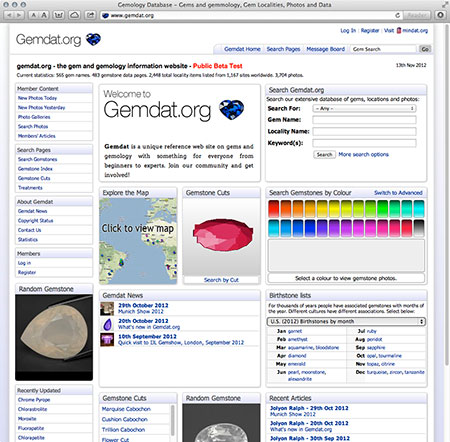 |
Just as with Mindat, Gemdat welcomes contributions from registered users, both photos and articles. Mindat account holders already are registered with Gemdat. In addition to the search tools you’d expect to see, Gemdat allows you to search by color—and we mean the actual color swatches are there for the picking, as shown above. Click on the darker edge of swatch and you get darker stones; on the lighter edge, a different batch is returned. And an advanced color wheel allows for more precise selections. A world map allows you to browse by locality. And you can choose from 80 cuts. Other search criteria: 15 treatments, nearly 600 gem names (both scientific and colloquial), and one search feature allows multiple criteria.
As of our visit, there were 565 gem names, 483 gemstone data pages, 2,448 total locality items listed from 1,167 sites worldwide and 3,691 photos. Updates are noted on the home page. All of this should keep visitors busily pointing and clicking. [back to top]
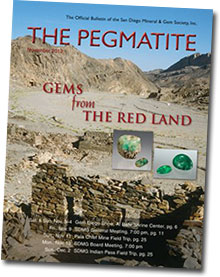 |
Members of the San Diego Mineral & Gem Society are lucky: they receive an electronic subscription to The Pegmatite, the nicely produced bulletin of the Society.
This month features “Gems from the Red Land,” an article by James A. Harrell, Professor Emeritus of Geology at the University of Toledo in Toledo, Ohio. The article is informed by 23 years and 33 visits to mines and quarries in Egypt, and beyond. The “Red Land” of the title, or Desheret, refers to the barren deserts that flank the rich Nile Valley and Delta. Lifeless, perhaps, but this is where Egyptians found lively carnelian and the meteoric Libyan Desert Glass as well as peridot, emerald, amazonite, amethyst, and turquoise, all of which are discussed and illustrated in the article.
This eight-page piece—focusing on some of the 31 varieties of material employed in Egyptian jewelry (and their mines)—should whet the appetite for Dr. Harrell’s in-progress book, Ancient Egyptian Rocks and Minerals: Varieties, Sources, Uses and Technologies. Although he has surveyed about 200 mines and quarries, in “Gems from the Red Land” Dr. Harrell drops tempting hints at the possibility of overlooked deposits of Dynastic (i.e., Pharaonic) varieties.
The Pegmatite is available to non-Society members in a reasonably-priced digital edition (as well as print edition). Details are on the San Diego Mineral & Gem Society website.
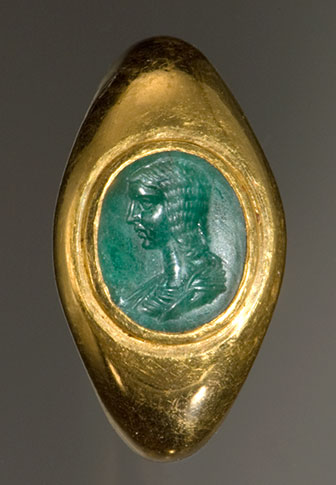 |
| Roman gold finger ring, above, set with an emerald, almost certainly from Egypt, engraved with the portrait of a member of the Severan dynasty, either the Empress Julia Domna (d. 217 C.E.) or the Princess Plautilla (d. 212 C.E.), Michael C. Carlos Museum, Emory University, Atlanta, gift of Michael J. Shubin. Emeralds, below, from the Wadi Sikait mine, collected by James A. Harrell. (Photos: Lisbet Thoresen) |
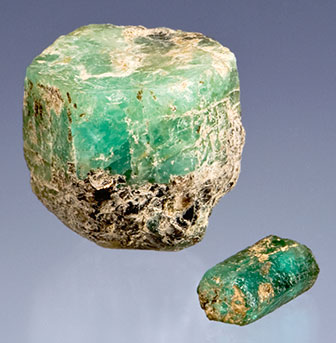 |
[back to top]
Gübelin Gem Lab issued a news flash last month stating that synthetic sapphires were being offered on eBay as being white HPHT-treated sapphires from Ceylon. The items were accompanied by forged Gübelin lab reports. Prospective buyers are urged to contact the lab for assurance of authenticity.
A quick, random check of eBay did not turn up any such certed stones, but browsers should beware.
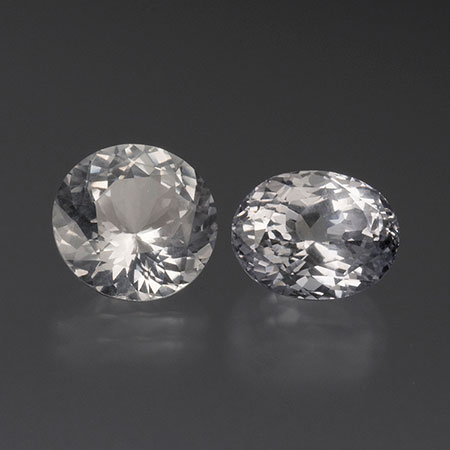 |
| Au naturel. Colorless, sparkly, simply beautiful: two natural colorless sapphires that have come (and gone) through the doors of Pala International. (Photo: Mia Dixon) |
[back to top]
Last month, in Bill Larson’s photo essay on his travels in Burma, we included a Chanel ad from the Bangkok airport, the ad’s model sporting slabs of Brazilian agate. This month, courtesy Brice Gobin and Jeanne Larson, we display more Chanel curiosities.
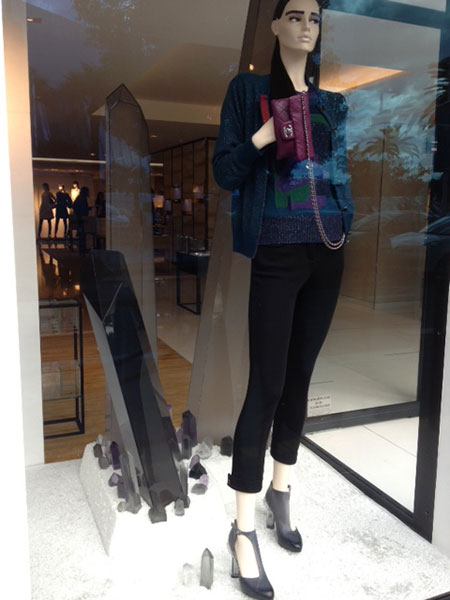 |
| Brice Gobin spotted this display in Cannes last month, on the Promenade de la Croisette. The mannequin even has amethyst eyebrows, he told us. |
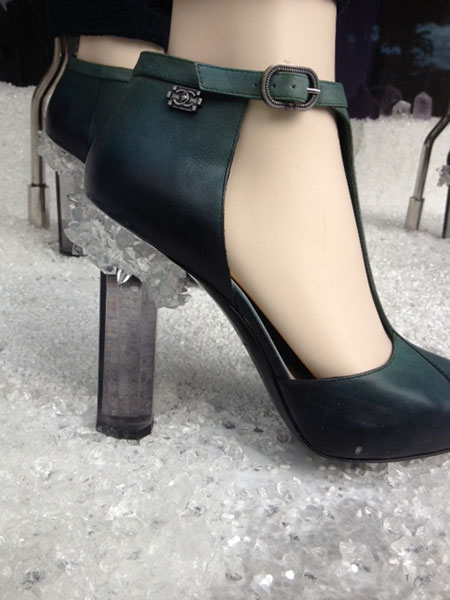 |
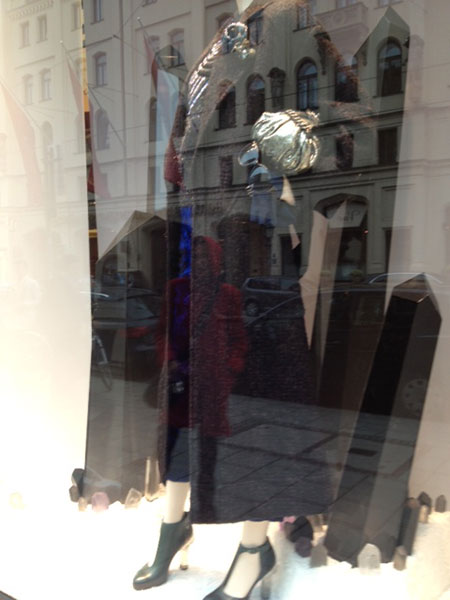 |
| Jeanne Larson noticed a similar display, in Munich. She told us that the quartz matrix and gray beryl of the heels actually are rendered in plastic. We liked the contrast of the (also plastic) oversized crystal terminations and the reflected windows and doors. |
[back to top]
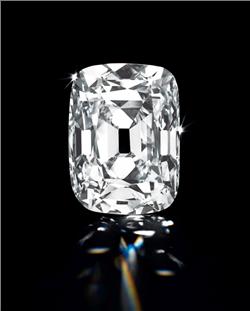 |
| The Archduke Joseph Diamond. (Photo: Christie’s press release) |
Some news of note in the diamond world.
Christie’s set three world records on Tuesday with the sale of The Archduke Joseph Diamond in Geneva. At nearly $21.5 million, the stone—a cushion D color internally flawless Golconda, 76.02 carats—fetched a record price for a colorless diamond at auction and a record price-per-carat for a colorless diamond. Also a record price for a colorless Golconda diamond.
According to a press release, Christie’s Geneva offered the stone in 1993, when it realized $6.5 million ($10.5 million today). The diamond, had its origin in the Golconda mines of India, said to be the source of many a famous diamond, such as the Hope and the Kooinoor. It became the possession of the House of Hapsburg before languishing in a safe during World War II, surfacing for auction in London in 1961, and again offered in 1993 after being slightly recut from 78.54 carats.
[back to top]
 |
| Our featured spinel from August 2010 still is available. It’s 10.21 carats of natural Burma beauty, with an old Gübelin cert and a new one from AGL. Inventory #18576. (Photo: Mia Dixon) |
Burma’s Central Statistical Organization released a slew of new data, including Fiscal Year 2011–12 totals. (See Burma Gem Sales and Statistics on Palagems.com for historical data.)
Production of gems, in carats, and other totals, compared with last year:
Also released were figures for April through August of this year. All seems about normal, with the exception of jade, which is way down. This is due likely to the fighting. But it’s also due to Chinese tariffs, discussed in an October 5 story by Eleven Media Group (EMG). Someone must have been listening to the complaints: two weeks later, China announced that gems from Burma would be added to a list of tariff reductions. Previously, gems had been taxed at a rate of 35%.
How about no taxes? The Myanmar Times (MT) reported on November 5 that the Burma black market with Thailand and China is “thriving”—nine times that of legal trade.
The New York Times (NYT) via its international edition, covered the conflict in Jade Land on October 17. Freelance journalist Swe Win, based in Yangon, did an overview of the conflict, some of the history, and the impact of war on the region. As the article points out, even displaced persons—reported to be about 100,000—often back the rebels with the hope that they can move back in when mining companies are ousted. After all, People Power worked last year to block construction of a hydroelectric project backed by the Chinese.
Earlier last month, MT covered the same subject. In late September, the main portion of Hpakant Road was shut down due to fighting, as reported by EMG.
EMG reported on October 30 that a new “emporium” is being built exclusively for the international jade market in Mandalay. The Minister for Commerce, Win Myint, said that the market would handle finished products. The market is being built by the Ministry of Mines.
Also in Mandalay, stone carvers’ workshops were ordered to relocate from the city’s Kyauksittan area. Complaints of noise, dust and jammed traffic led to the order. On September 12, as reported by MT, U Soe Naing of Aye Aye Khaing jade trading company offered the workshops 1.5 acres adjacent to an 11-51-acre site that the trader is giving the International Mineral Jewellery Market (Mandalay). The hope is that synergy between the two will lead to more jade carving. The order, with a deadline of September 9, has not been enforced, and many workshops are waiting for official clarification, per an October 29 story.
 |
| Going twice… Also mentioned in 2010; we called attention to this 3.12-carat blue sapphire from Burma. Inventory #12283. (Photo: Mia Dixon) |
[back to top]
— End November Newsletter • Published 11/15/12 —
 |
In this edition of our newsletter we note the passing of Andrew Sarosi, gem dealer extraordinaire.
A legend in the gem industry passed away on October 11. A friend and colleague to many, he will be missed. Everyone here at Pala International sends our deepest sympathies out to friends and family. Andrew surrounded himself with some of the finest gems and people on the planet. A scholarship fund has been set up in Andrew’s memory; see details here.
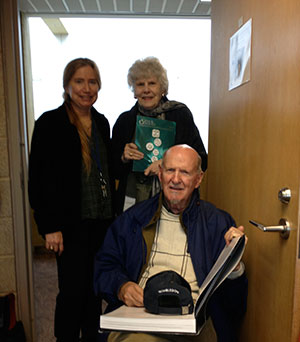 |
| Oh, those Hugheses; they’re so romantic… Your editor’s parents, Robert and Phyllis Hughes, celebrate 60 years of marriage last week in the office of Elise Skalwold at Cornell University. |
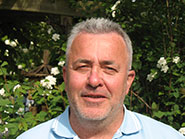 |
Gemologist Nicolas Zylberman has a long interest in many subjects that touch the realm of the history of gemology. This coming Saturday, October 20, he will make two presentations—in French—on topics in his fields of study, in the Gemforum, sponsored by the Association Gemmologique de Belgique (Gemological Association of Belgium), in Louvain-La-Neuve. See details in this bilingual announcement, from which the following is taken.
« La Corporation des Lapidaires, de la Renaissance à la Révolution française »: The gem-cutters/lapidaries corporation [or guild] finds its roots in the Middle Ages, a period where we can trace its first records.
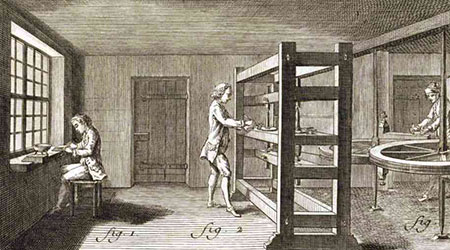 |
They established themselves as a proper corporate entity at the end of the 16th century. Until the French Revolution (1789) they fought to get the title of Merchant, a title reserved to five corporations which included goldsmiths. From then on, they focused on the control of merchandise imported more or less legally by “bankers,” stallholders or Marranos* diamond dealers belonging to powerful Flanders hub and from hegemonic Holland. After numerous trials, edicts, laws, blow-down, two centuries later Parisian lapidaries had even lost their reputation as gem cutters.
__________
*Marrano was a derogatory term applied to “conversos,” or Jews in Spain and Portugal who converted to Christianity in the face of discrimination and expulsion. —Editor
 |
« Les Sources des dénominations gemmologiques »: The names of gems come from three etymological sources. After using the shortest path to designate objects, the scientists of the nineteenth century will realize “that most mistakes that are in their concepts and in their disputes come from the words and their uncertain or misunderstood meanings, [and] we believe that all about this fault is not a small obstacle to true and solid knowledge.”
John Locke (1632–1705, pictured at right), who is the father of this philosophy, emphasizes: “A word must translate ideas and must be a connection to reality; it is the language of truth.” [back to top]
Madeleine Albright, the first female U.S. Secretary of State, famously used her jewelry as a statement in her position as Secretary and before that as Ambassador to the United Nations.
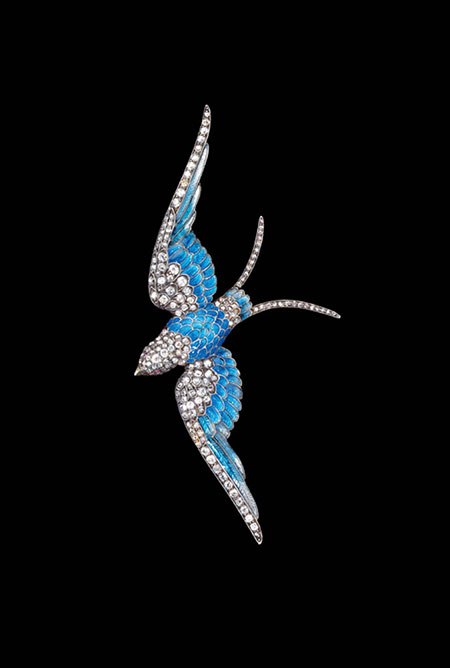 |
| Blue Bird, circa 1880. Anton Lachmann, Austria. 14kt yellow gold, silver, enamel, rubies, diamonds; 4.3 x 2 in. (Photo: Museum of Arts and Design, New York, courtesy Bowers Museum) |
Take, for instance, “Blue Bird,” a pin composed of dozens of diamonds and two rubies for eyes, with blue-enameled feathers. Designed by the Austrian Anton Lachmann, it dates to about 1880. Depending on which account you read, this pin was perhaps the first that Albright used in a political way, having donned it while ambassador to the United Nations in 1996, and pinned it so it soared upward. On February 24, upon hearing that Cuban jet fighters had shot down two aircraft belonging to a Cuban exile group, Albright wore the pin upside down at a UN press conference in which she denounced the Cuban government, using unconventional language. (The account from her book, Read My Pins, is excerpted here.)
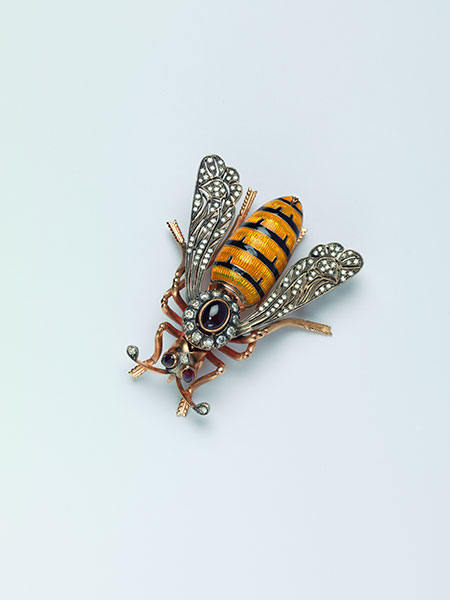 |
| Bee, circa 1980. (Click to enlarge.) Designer unknown, USA. 14 kt pink gold, silver, enamel, diamonds, garnets; 2.4 x 1.9 in. (Photo: Museum of Arts and Design, New York, courtesy Bowers Museum) |
“Read My Pins: The Madeleine Albright Collection” is an exhibition of more than 200 pieces from Albright’s jewelry box, on display at Southern California’s Bowers Museum from October 20, 2012 through January 13, 2013.
Jade has been fashioned in China since the Neolithic period, and jade objects from as early as 3500 B.C.E. have been found there in tombs. An ongoing exhibit at the Bowers, “Ancient Arts of China: A 5000 Year Legacy” features jade objects, such as a jade cong (a square-shaped cylinder) that dates from between the 31st and 22nd centuries B.C.E. [back to top]
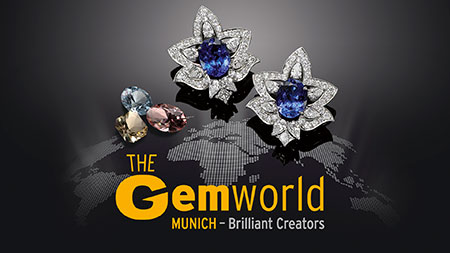 |
Pala International will be offering fine mineral specimens at this year’s Munich Show.
When: October 26–28, 2012
Where: Munich Trade Fair Centre
Hours:
Friday, October 26: 9:00 AM – 7:00 PM (Trade only)
Saturday, October 27: 9:00 AM – 7:00 PM
Sunday, October 28: 9:00 AM – 6:00 PM
Booth: Hall A6 Pavilion Booth 27
This year’s special exhibit is titled “African Secrets,” which will feature more than 300 pieces from private collections as well as those of museums in London, Paris, Milan, Johannesburg, Brussels, Los Angeles and Luxembourg. Localities and minerals represented will be vanadinites from Mibladen in Morocco, malachites and wulfenites from Congo, tanzanites from Tanzania, and tourmalines, aquamarines, fluorites and more from Erongo and Tsumeb in Namibia. De Beers will exhibit one of its largest octahedron diamonds at the show. This exhibit will be covered in the debut of the Theme Book, a high-quality hardcover, which will be published in addition to the show catalog. Both publications will be delivered from the show store beginning October 1.
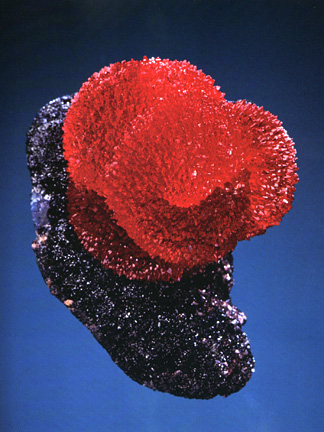 |
| Rhodochrosite on manganite. One of the world’s most famous mineral specimens, aptly named “The Snail,” was acquired by Bill Larson in South Africa in 1976. It will be included in the “African Secrets” exhibition. (Photo: Jeff Scovil) |
Along with Bill Larson’s “The Snail,” pictured above, the “African Secrets” exhibition will include two specimens from Will Larson: an olmiite nicknamed “Mickey Mouse” and a prehnite nicknamed “deadmau5”—quite a pair!
 |
| deadmau5. The “real”-life deadmau5 is a DJ based in Toronto. We can’t wait to see his mineral mirror-image. |
As usual, there are many activities for the junior set, such as gemstone faceting, but another activity is available to children of all ages—if you are visually impaired, that is. The “Comprehending Stones” exhibit, presented by Mr. and Mrs. Schwinghammer, is hands-on, “from the edgy surface of a pyrite to the soft texture of a soapstone.”
For more information visit the show website. See the Pala International Show Schedule for future events.
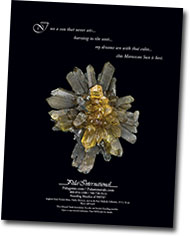 |
| See our ad in this year’s program. |
[back to top]
The spinel family continues its campaign into the world as its color cornucopia and exquisite properties continue to impress. As the rarity and beauty of the spinel varietals disseminate, the collectors seem to be acquiring a taste for this rising phoenix. We in the trade have always had a love for spinels, but now it seems the secret is out. We can’t seem to keep up with the requests for fine reds and blues. So we are constantly scouring old collections and keeping an eye on material coming out of the major spinel-producing regions, mainly southeast Asia and eastern Africa.
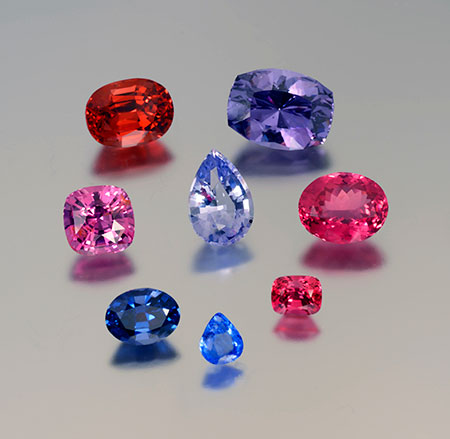 |
| Spinel spectacle: Clockwise from top left, 8.07-ct orangey red Burma oval (Inv. #20439), 12.37-ct lavender Burma cushion (#20436), 7.11-ct pinkish red Tanzania oval (#20468), 1.8-ct flame red Burma cushion, 1.26-ct cobalt blue Vietnam pear shape (#20502), 3.73-ct cobalt blue Burma oval (#20467), 6.14-ct purply pink Tajikistan cushion (#17979). Center, 5.90-ct violet blue Vietnam pear shape (#20437). |
We had the great fortune recently to buy a large gem collection filled with a variety of spinels, in an array of colors and sizes. Bill Larson also is just back from another buying trip to Bangkok and Burma. Above, we offer just a few highlights from these purchases…. Enjoy!
Interested? Call or email us to inquire.
See also this May 2011 article on spinel from Rapaport that quotes Pala’s Jason Stephenson. [back to top]
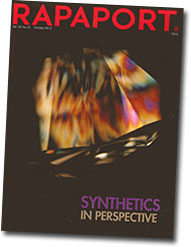 |
Pala International’s Jason Stephenson was quoted in this month’s Rapaport Magazine, in an article on “watermelon” tourmaline, so named for its resemblance to the green-skin/red-flesh fruit.
As Jason explains in the article, titled “Two Hues,” the colors in these tourmalines are caused by interaction with elements—iron, in the case of the green material, manganese in the case of red material, and lithium in pink.
Supplies of the bi-color gemstone are dwindling, Jason explained, whether from Afghanistan, Brazil, Nigeria, Madagascar or, of course, Southern California. Nevertheless, Pala International has a large selection of weights and cuts.
 |
| Classic watermelon tourmaline in earrings offered by Pala International’s sister enterprise, The Collector Fine Jewelry. Inventory #20369. (Photo: Orasa Weldon) |
[back to top]
A year ago we noted a planet made of diamond discovered by researchers at Melbourne’s Swinburne University of Technology. This month, researchers in Toulouse have identified a “diamond-rich super-Earth.” It distinguishes itself from previously discovered diamond planets because it is orbiting a sun-like star.
See Reuters for more on the planet.
 |
| The planet in question is known as 55 Cancri e. This artist’s rendering shows the planet very close to its sun. Its year lasts only 18 of our own hours. (Illustration: NASA) |
[back to top]
A noteworthy specimen of amber was discovered recently in the Hukawng Valley of Myanmar. Tree resin encapsulated a spider and prey, creating a dramatic scene that is estimated to have been preserved for about 100 million years. (See photographs here.) This Early Cretaceous spider is frozen in time, getting ready to make a meal out of a web-entangled wasp. Strands of the spiders silk can be seen running throughout the specimen. This time capsule has traveled from the age of the dinosaurs, and it is believed that spiders actually date back more than 200 million years.
Pala International has been involved in some of the amber trade over the years, bringing to market unique pieces of amber with critters such as ants, flies, pill bugs, wasps, mosquitoes, and even rare pieces with mushrooms, flowers and scorpions inside. Pala has also been buying some of the clean amber recently with no inclusions whatsoever. See our previously featured amber here.
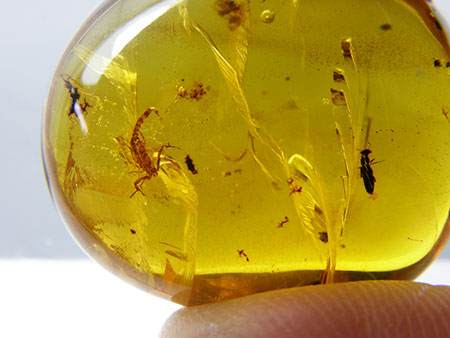 |
| Well preserved scorpion on the left and some sort of winged bug on the right. This material, also known as burmite, was written up in the Summer 2012 edition of Gems & Gemology. Have an iPad? You can download the G&G app for free. This specimen is now in the collection of Bill Larson. (Photo: Prasit Prachagool) |
[back to top]
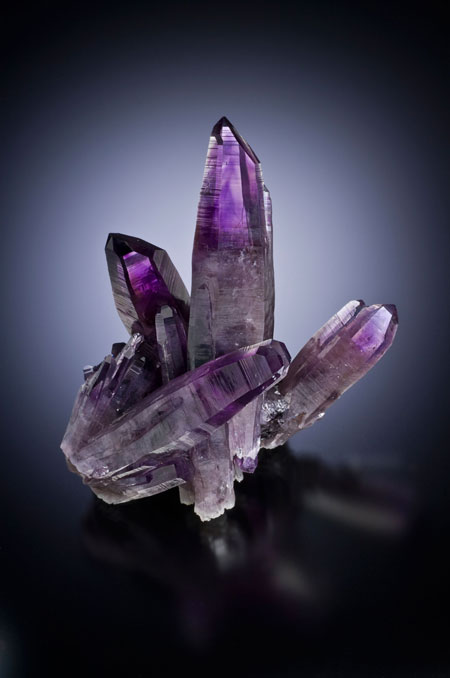 |
| Quartz, variety amethyst, 9 cm tall, Amatitlán, Guerrero, Mexico. Bill Larson collection. (Photo: Jeff Scovil) |
No. 16 in Lithographie’s monograph series is so visually luscious one’s mouth actually begins to water as page after page of exquisite purple-hued imagery greets the eye. This long anticipated volume brings together a diverse group of authors and photographers whose passion for this most highly-prized variety of quartz is self-evident in each of their contributions.
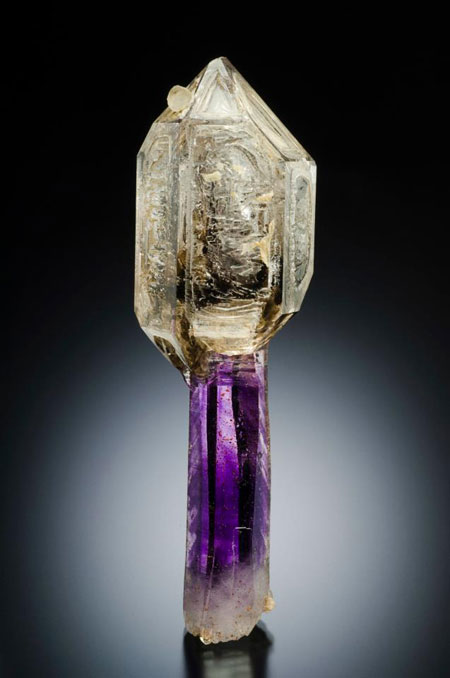 |
| Quartz variety amethyst, 14.8 cm tall, Goboboseb Mountains, Erongo region, Namibia. Charles Cecil collection. (Photo: Jeff Scovil) |
Most appropriately, the volume opens and closes with the conjoined pens of the royal sovereigns of quartz, Si and Ann Frazier, as they offer first a historical overview and then a comprehensive glossary of terms related to amethyst. What comes in-between leaves few mysteries untouched. Mineral collectors and gem enthusiasts of all levels will appreciate not only the aesthetic presentation, but also the level of detail contained in this volume, one which will surely become a standard reference on amethyst for years to come.
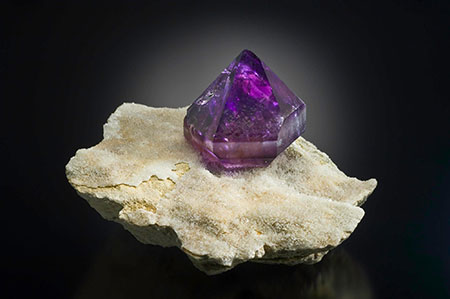 |
| Quartz variety amethyst, 12 cm wide, Hunan Province, China. David Daniel specimen. (Photo: Jeff Scovil) |
Congratulations to Gloria Staebler and her team at Lithographie, Ltd.! Amethyst, Uncommon Vintage is destined to become a collector’s item, just as have the now hard-to-find titles such as Tourmaline, Emeralds of the World, and Gold. With that in mind, and at its very reasonable price, one might even consider purchasing two copies, preserving one as pristine as the day it came off the press.
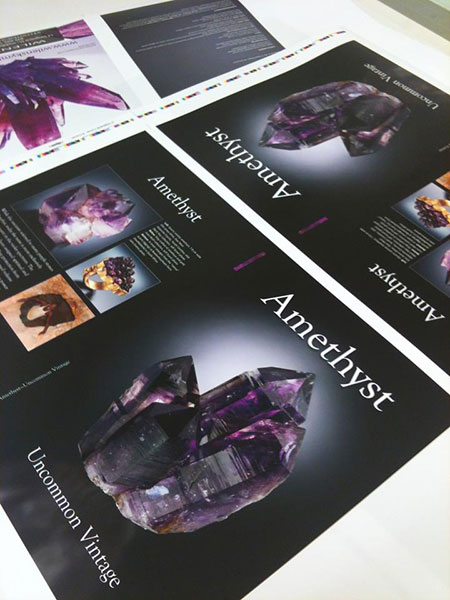 |
| Proofs of the cover for Amethyst, Uncommon Vintage. (Photo courtesy Lithographie, LLC) |
Amethyst, Uncommon Vintage is available from the publisher. For a more in-depth review, see the upcoming 2012 Journal of Gemmology.
Contents
Lithographie offers Reinhard Balzer’s Amethyst Uruguay. Published in 2008, it includes 223 color illustrations. See also our news items on amethyst from Uruguay from our sister publication, Pala Mineralis.
The members of the staff of Pala International sends their condolences to Gloria Staebler on the death of her father this week. Our thoughts are with you.
[back to top]
The gemology profession received a dose of promotion last month when the syndicated television series “Career Day” aired a segment featuring prominent gemologist and author John Koivula. By the end of September, the piece had appeared in nearly fifty cities across the country on major networks. The segment’s narrator sounds a little breathless, but the piece, which runs just over three minutes, is a good blend of eye- and ear-candy together with factual morsels. Koivula’s history and motivation regarding gemology also are covered.
 |
| Click to play the John Koivula “Career Day” segment. |
[back to top]
Sotheby’s announced last month that it had entered into a partnership that would make it “the first international fine art auction house in China.” The deal, struck with Beijing GeHua Art Company, based in Beijing, expands Sotheby’s presence in China from Hong Kong to the mainland. Sotheby’s will maintain an 80% ownership of the venture, according to Associated Press. The joint venture involves a prospective free port project that will allow GeHua to exploit Beijing’s Tianzhu Free Trade Zone, which will include a tax-advantaged storage facility, among other boons.
The Sotheby’s announcement stressed that the auction house would “focus on auctions and selling exhibitions of non-cultural relics, traveling exhibitions and other related activities.” Sotheby’s was to mark the occasion with an inaugural sale of a sculpture by Chinese artist Wang Huaiqing and two exhibitions—one, a contemporary-themed display and the other, a survey of Sotheby’s “international presence, world-class expertise and important events from Sotheby’s more than 260-year history.” Wang’s sculpture fetched $222,222 according to Artinfo China.
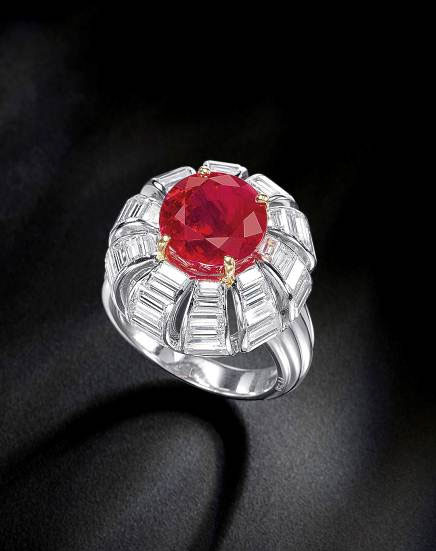 |
| Daisy. On October 9, Sotheby’s Hong Kong sold this 9.08-carat pigeon’s blood Burma ruby ring for $3.3 million. It was crafted by Cartier in 1956. (Photo: Sotheby’s press release) |
[back to top]
This month we devote Burma Bits to the following.
Bill Larson just completed his 34th trip to Burma. Along the way he also attended the September Hong Kong Jewellery & Gem Fair. Larson is hoping Americans can do business again in Burma once the sanctions are rescinded. He just browses now.
See this photo essay in which the images pretty much speak for themselves.
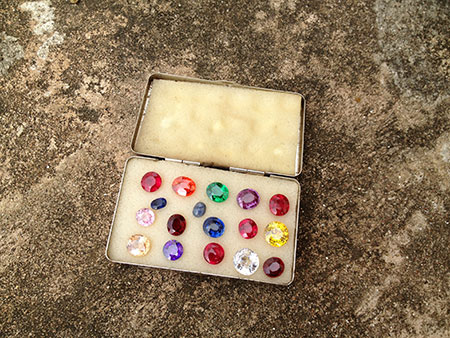 |
| New and old. A variety of synthetics, above, were offered outside the Shwezigon Pagoda, below, in Bagan. The temple was completed in 1102. The sellers guarantee these are real Mogok gemstones. Very hush-hush. (Photos: Bill Larson, from the photo essay) |
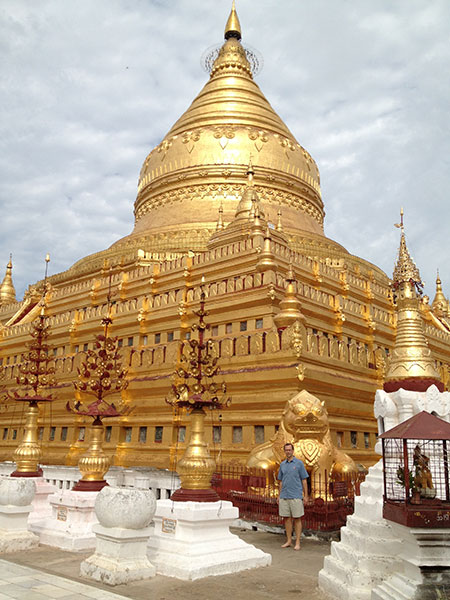 |
 |
| Chanel. Bill Larson also traveled to Bangkok last month. The image above was posted in the Bangkok airport. The ad’s model features slabs of Brazilian agate. |
[back to top]
— End October Newsletter • Published 10/16/12 —
In this edition of our newsletter we do more globe-trotting: the gem shows in Hong Kong and Munich, our featured stone from Tanzania, mail from near and far, a titanic diamond deposit in Russia, a ruby ring from Palo Alto, news both hopeful and unsettling from Burma, and kunzite from San Diego County.
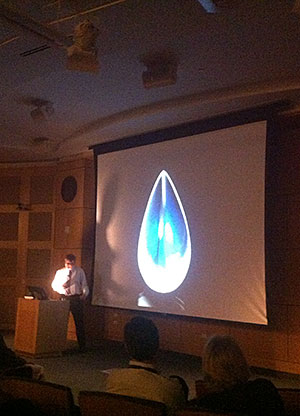 |
| Pala’s Bill Larson discusses moonstone as part of his topic, “Burma’s Ancient Valley of Gems and Rubies,” at the Dallas Mineral Collector Symposium last month. |
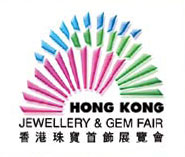 |
Pala’s Bill Larson is attending this fall’s largest international jewelry fair in Asia. The show is held at two venues:
According to the show website, the 2011 fair was attended by a 16.3 percent increase in visitors, setting a record for the number of both attendees and exhibitors.
A press release states that this year’s fair sees the debut of the Poland Pavilion, the show’s twenty-second group pavilion.
Rapaport reported on September 7 that Hong Kong’s jewelry-related sales from January through July increased 10 percent, to $7.2 billion. July sales increased 0.9 percent, to $1 billion, but that was a drop of 3.1 from 2011.
American Gemological Laboratories announced last week that it will perform on-site testing of colored gemstones during the show, from September 19 through 25. Appointments are encouraged by contacting +852-976-51-732 (Hong Kong) or +1-212-704-0727 (New York). [back to top]
 |
Pala International will be offering fine mineral specimens at this year’s Munich Show.
When: October 26–28, 2012
Where: Munich Trade Fair Centre
Hours:
Friday, October 26: 9:00 AM – 7:00 PM (Trade only)
Saturday, October 27: 9:00 AM – 7:00 PM
Sunday, October 28: 9:00 AM – 6:00 PM
Booth: Hall A6 Pavilion Booth 27
This year’s special exhibit is titled “African Secrets,” which will feature more than 300 pieces from private collections as well as those of museums in London, Paris, Milan, Johannesburg, Brussels, Los Angeles and Luxembourg. Localities and minerals represented will be vanadinites from Mibladen in Morocco, malachites and wulfenites from Congo, tanzanites from Tanzania, and tourmalines, aquamarines, fluorites and more from Erongo and Tsumeb in Namibia. De Beers will exhibit one of its largest octahedron diamonds at the show. This exhibit will be covered in the debut of the Theme Book, a high-quality hardcover, which will be published in addition to the show catalog. Both publications will be delivered from the show store beginning October 1.
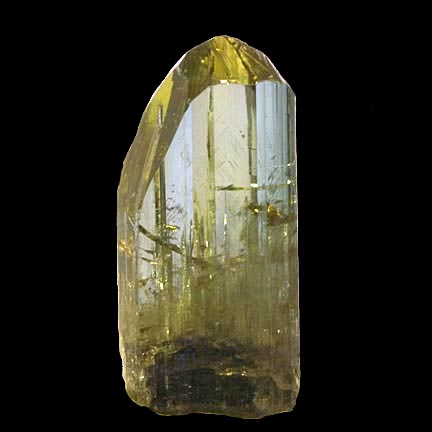 |
| Zoisite, whose blue and violet varieties are known as tanzanite (below left, Inv. #20398), comes in a range of hues, as shown below right (Inv. #19328). The yellow-green crystal pictured above has hints of blue at opposite angles, with the lower quarter sporting a lavender color. Inventory #19245 from Palaminerals.com. All items from Tanzania. (Photos: Above, John McLean; below, Mia Dixon) |
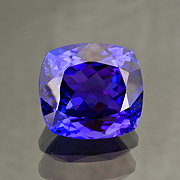 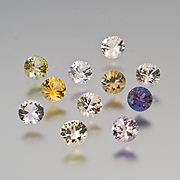 |
As usual, there are many activities for the junior set, such as gemstone faceting, but another activity is available to children of all ages—if you are visually impaired, that is. The “Comprehending Stones” exhibit, presented by Mr. and Mrs. Schwinghammer, is hands-on, “from the edgy surface of a pyrite to the soft texture of a soapstone.”
For more information visit the show website. See the Pala International Show Schedule for future events.
 |
| See our ad in this year’s program. |
[back to top]
This month we feature a purple scapolite from Tanzania.
This scapolite has a phenomenal purple hue, reminiscent of the finest amethyst, one of the most saturated and pure colors we have seen here at Pala. This scapolite is virtually flawless and has an exquisite trilliant cut with a very symmetrical brilliant-style faceting. Most scapolite you see from Tanzania is more often in the yellow color spectrum, but every once in a while an intense purple, like the one seen below, is produced. This gem is from an older collection Pala bought recently, so it’s hard to pinpoint a specific locality, but it’s probably from the Morogoro region in Tanzania. Other fine purple scapolites have been coming out of China and Afghanistan more recently.
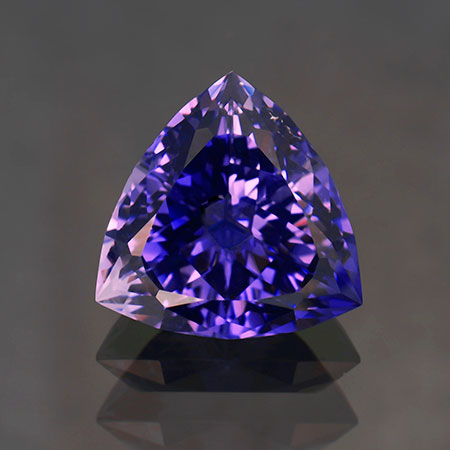 |
| Purple scapolite, 15.26 carats, about 17.3 mm. (Photo: Mia Dixon) |
It’s been three years since we passed along the feedback we’ve received from a smattering of our readers. Note: Affiliations are for identification only; they should imply no endorsement by an organization or institution.
 |
I love your newsletter. Excellent work. —Jamie Newman, Senior Scientific Assistant, Minerals and Gems Earth and Planetary Sciences, American Museum of Natural History, in response to our August 2012 and October 2009 newsletters
I look forward to your reports every time. They're getting better and better. —Charles I. Carmona, GG, ASA, President, Guild Laboratories, Inc., Los Angeles
I have always enjoyed Gem News and often see specific articles that I would like to share with customers and members of our local gem and mineral society. The Tridacna pearl in the October newsletter is a good example. —Gene Schade, Casa de Oro, Inc., Corpus Christi
The best yet! What a great newsletter. I want these books that you mention and review…all of them. Please put me on the list to receive them. —Helen B. Davis, in response to our notice of publication of Richard W. Wise’s The French Blue: An Illustrated, Historic Novel of the 17th Century and the Origins of the Hope Diamond
Thank You, Palagems for another great issue of Gem News. This continues to be the best gem oriented newsletter I receive. The images, the articles, the information and the links all contribute to its excellence. —Leon Weiner, Vinocour Gems, Fairfield, Iowa, responding to our December 2009 newsletter
Dear Bill, Your newsletter continues to outshine all others which I receive. Thank you for all the effort. Taking a break to read the publication is truly a pleasure. —Paul S. Harter, Tucson Gem and Mineral Society, in response to our February and March 2010 newsletters
Your Gem News I find INESTIMABLE [in value]… Keep them coming… All the best. —Joyce Vacek, ’49er Minerals, Scottsdale, regarding our February 2010 newsletter
I, Mr. Haq Nawaz of Abdali Gemstones, Peshawar, Pakistan, am greatly thankful for your continuous updates on the gemstones information. The report about Afghani tourmaline and kunzite is really good for a layman like me. I read all your updates with great attention. You have really provided great information. —Regarding our March 2010 newsletter
I have to say that you guys put together the very best website in the US jewelry/gem profession. I congratulate you on this achievement. Your old pal and admirer, Gerry Manning, Manning International, Fairfield, Connecticut
Thank you again for another great presentation. Sui generis!, of course. I apologize for not having thanked You so many times before. I am an old acquaintance, sphene, etc., enthusiast. —Lester “Lyn” Sanny, DDS, regarding our October 2010 newsletter
Great issue. I very much enjoy receiving the Palagems report. —John Block, Block-Guest Group, formerly of Sotheby’s, on our November 2010 newsletter
I just wanted you to know that I very much enjoy your e-newsletter. The articles are always of interest and well-written. It must take many hours to prepare this type of excellence. I look forward to future issues, especially of Martin Ehrmann’s manuscripts. That was a real treat. —Norbert Hobrath, Hobrath Group, Strongville, Ohio
Thanks for the News! Congrat’s, Bill…what a lovely story! And thank you also for the pix with a sapphire…looks great! Be strong! —Nikolai Kuznetsov, Stone Flower, Fallbrook and Moscow, saluting Bill Larson on his receipt of the Diplome d’Honneur at the Ste-Marie show, and commenting on his own photo in our Burma Bits column for July 2011
Bill, I don't know who is populating your website with luscious articles and photos, but it could surpass Gems & Gemology in interest, readability and information. I could spend a couple of hours here (and will). I am making it a must read for my staff. Whoever it is, pay them more. They are worth it, and thanks for nudging me back to the site for a closer look. It’s awesome. —Martin Fuller, Martin Fuller Appraisals, McLean, Virginia
I am an independent jewellery designer/manufacturer and a director of the Gemmological Association of HK (Publications Director). I was also Gem-A representative in Hong Kong for a few years. I receive your newsletter each month and thank you for that. —Anne Carroll Marshall, Hong Kong, in the course of inquiring about the availability of a pair of spinels
I can’t express too often how much I appreciate the work all of you put into this excellent newsletter. It is so educational. I almost don’t miss not being able to see these places and specimens in person. Thank you so much! —Gail Wilder, regarding our August 2012 mineral newsletter
Thank you to Antoinette Matlins, Mike Peters, John S. White, Dona Dirlam, Sammye Walton, Phyllis J. Hughes, Richard W. Hughes and all the Pala staff for catching our typos!
Be sure to catch the new items in Pala’s Mailbag. [back to top]
Russian officials have lifted the lid on a diamond deposit that was discovered in the early 1970s yet abandoned and classified for reasons of alternative development. The deposit is at the Popigai asteroid impact crater, 62 miles in diameter, in northern Siberia. Although classified, an international expedition visited the area in 1997, and Wikipedia references several scientific studies from the 2000s. A 2000 study, published in the Indian geoscience journal Episodes (Vol. 23, No. 1), noted: “It was only announced recently that the total amount of diamond in the Popigai impactites exceeds the resources in all other diamond provinces in the world.”
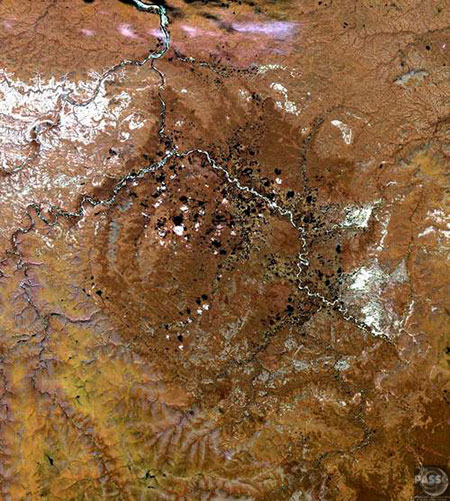 |
| Landsat image shows the Popigai crater area. (Photo by Ronald W. Hayes, courtesy Planetary and Space Science Centre, Canada) |
The diamond deposit was written up on September 16 by Russia’s Itar-Tass news agency following an announcement by the Institute of Geology and Mineralogy at the Siberian Branch of the Russian Academy of Sciences. Institute director Nikolai Pokhilenko said that the first results of research led to talk of “a possible overturn of the entire world market of diamonds.”
The Popigai diamonds—impact diamonds—are two times harder than run-of-the-mill diamonds, making them ideal for industrial applications. And did we mention that the deposit is huge? Pokhilenko spoke of “trillions of carats.” This compares with the reserves in Yakutia, which he pegged at one billion carats. (See this Daily Mail article for a photo of 50-plus-carat Yakutia diamonds.) Popigai, then, could supply the world for 3,000 years, according to unnamed scientists.
A writer for Tecca speculated that this deposit could be valued in the quadrillions of dollars. [back to top]
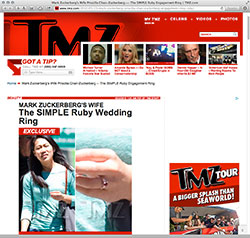 |
| Gossip sites like TMZ were a-twitter with speculation on whether Priscilla Chan was disappointed by the modest wedding ring. |
Given how much time we spend on Facebook, how did we miss it? Way back in May, social media Mark Zuckerberg married longtime girlfriend Priscilla Chan. The surprise wedding took place in the backyard of the home they share in Palo Alto. The occasion, or so thought 100 guests, was to celebrate Chan’s graduation from medical school.
At the wedding, Zuckerberg presented Chan with a ruby wedding ring that, according to Us Weekly, he designed himself. Of course, the simplicity of the ring, shown on the finger of the bride on various websites days before their honeymoon, was called into question given the groom’s immense wealth.
The Us website includes a photo of the wedding ring (below top). The site also states that Dutch jeweler Royal Asscher was offering a “version” of the ring. When we spoke with Royal Asscher’s New York office we were told the firm continues to offer the ring, which is not a replica per se (below bottom), but is similar to the Zuckerberg creation. (And, no, Royal Asscher did not execute Zuckerberg’s design.)
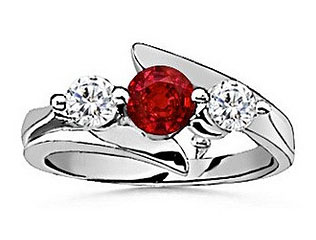 |
| Above, the Mark Zuckerberg-designed wedding ring. Below, the Zuckerberg-inspired ring offered by Royal Asscher. (Photos courtesy Royal Asscher, New York) |
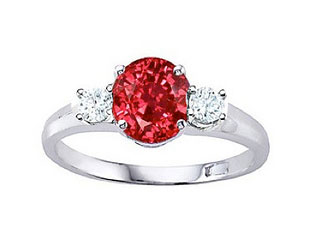 |
[back to top]
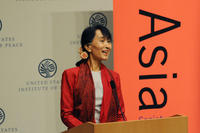 |
| Suu Kyi addresses USIP. (Photo: USIP) |
Yesterday, on the first day of her current 17-day visit to the U.S., Aung San Suu Kyi called for an end to sanctions against Burma. Speaking before the United States Institute of Peace (USIP), she said, “I do not think that we need to cling on to sanctions unnecessarily, because I want our people to be responsible for their own destiny and not to depend too much on external props.” (The EU yesterday announced its own plan to lift sanctions.)
Today Suu Kyi was scheduled to receive Congress’s highest honor, the Congressional Gold Medal, but this belies the fact that some Burmese in the U.S. would be boycotting the ceremony, according to Kachin News Group (KNG). At issue is the fighting in the jade-producing state of Kachin, which has caused workers to flee, denying them their livelihood. An open letter to Suu Kyi’s National League for Democracy from the Kachin Alliance USA listed five areas of intervention requested of Suu Kyi, who is now a member of parliament. On September 14, KNG published an article titled “Hpakant’s jade war heats up in western Kachin state,” one of many reports in several press organs of the Burmese diaspora.
The KNG article quoted aid workers as saying that the conflict in Hpakant, which began August 18, has caused at least 10,000 people to become homeless. And if fighting wasn’t a challenge, the weather was: Democratic Voice of Burma reported September 6 on 800 internally displaced persons having to relocate due to flooding. Earlier, KNG wrote about flooding in Hpakant that had started on July 16. Eleven Media Group reported yesterday that the population of Hpakant had dropped from 200,000 to 20,000. The evacuation has led to looting and vandalizing, as stated by Mizzima News on September 7.
The conflict and weather have had their effect on the Mandalay jade and gem market. Traders there, according to The Myanmar Times, claimed that mining in Hpakant had ground to a halt in late June. The market is forced to rely on existing stock. Gem trader U Myo Zaw opined that the government told miners to quit due to rain, but the conflict there was the actual reason. Another merchant, U Kyaw Kyaw, felt that of the 500+ mining companies in Hpakant, most are fronts for Chinese firms. Gem Broker U Soe Naing said that faceted stones selling for around $60,000 were selling well, but those in the $120,000 range had little market.
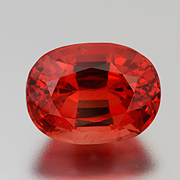 |
| Mmm… Lovely red spinel from Burma, 8.07 carats, Inventory #20439. (Photo: Mia Dixon) |
In July, gem trade officials and others completed a draft of legal rules that will govern how gem work will be conducted in Kachin state, according to a July 20 report by Mizzima News and others. The reports stated merely that the draft was based on language from the 2008 constitution and that all work in Kachin is subject to taxes, that it must be recorded in detail and work not reported is subject to prosecution. The draft goes before the state government and Union government for approval.
Meanwhile, on September 7, KNG reported that the Kachin Independence Organization has implemented new rules for mining in the Hpakant jade district, even though mining has scaled back due to fighting. Each mining firm can have no more than 10 security guards, which must be registered with the KIO army. The army must be notified of Burmese government or troop visits and the firms are prohibited from interfering with artisanal miners.
A mining summit was held July 22–24 in Yangon, attracting 300 attendees from 26 countries, according to The Myanmar Times. This first-ever conference for Burma is remarkable because some outside investors have been barred from Burma due to international sanctions. A rule banning exports of ore [sic], coal, gold and gemstones was discussed, but the present situation in which foreign traders must buy the latter from gem emporiums appears to remain unchanged.
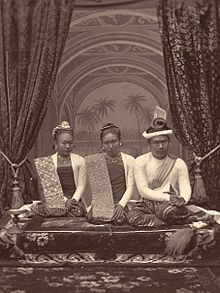 |
| Taw Taw’s grandparents (center, right) and his aunt, Princess Supayaji, in 1885. |
Last month we featured an excerpt of Sudha Shah’s book, The King in Exile: The Fall of the Royal Family of Burma. On July 30, The Myanmar Times published a memorial by Ma Thanegi to the last surviving grandson of the last king of Burma. He was born on that date in 1926, dying in 2006.
Taw Paya Galay was born to the fourth daughter of King Thibaw and Queen Supayalat, Lady Hteik Su Myat Paya Galay. According to the memorial, she was referred to as the Rebel Princess due to her feisty nature. It’s said that she helped seize power for her husband by slaying their rivals.
In 1932, she and her husband were exiled from Mandalay to the coastal town of Mawlamyine; she had demanded that the British rulers return the royal gems and jewelry that they had taken. Taw Paya Galay had his own rebellious nature, as you can read in the memorial. After Burma’s independence, Taw Taw, as he was known, became an exporter of imperial jade until his company was nationalized.
[back to top]
With Pala Presents, we offer selections from the library of Pala International’s Bill Larson, who will share with us some of the wealth of information in the realm of gems and gemology.
In 1903, when he wrote his paper on spodumene, Waldemar T. Schaller (1882–1967) was at the beginning of a 60-year career with the United States Geologic Survey. That summer he had just received his bachelor’s degree from the University of California when he visited the spodumene locality in San Diego County.
According to a German-language Wikipedia article (translation here), Schaller wrote more than 40 descriptions of new minerals, including sicklerite—named for the family whose story we are reprinting on our sister website—and stewartite—named after the Stewart pegmatite in Pala, Calif. In 1925 the mineral schallerite was named in his honor. A bibliography of his work, 1901–1953, and memorial are available from the Mineralogical Society of America.
Schaller’s paper on spodumene discusses the science of the material in much detail. Coincidentally, with the publication of the paper, it was announced that the material had been given a name: kunzite.
Read “Spodumene from San Diego Co., California.”
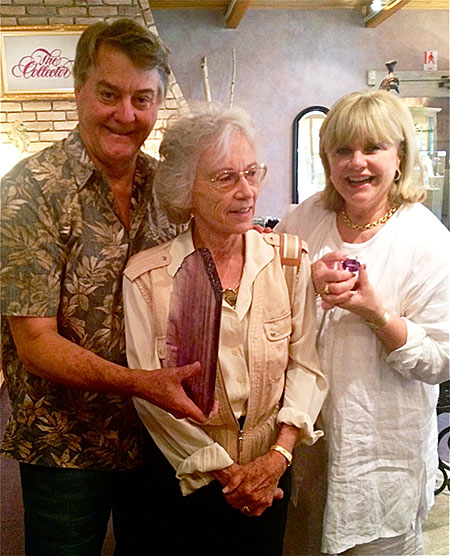 |
| Rough and cut. Bill and Jeanne Larson hold large kunzites as gem and mineral photographer Erica Van Pelt looks on. (Photo: Geri Vigil, The Collector Fine Jewelry) |
[back to top]
— End September Newsletter • Published 9/19/12 —
2015.3 | 2015.2 | 2015.1
2014.3 | 2014.2 | 2014.1 | 2013.3 | 2013.2 | 2013.1 | 2012.3 | 2012.2 | 2012.1
2011.3 | 2011.2 | 2011.1 | 2010.3 | 2010.2 | 2010.1 | 2009.3 | 2009.2 | 2009.1
2008.3 | 2008.2 | 2008.1 | 2007.3 | 2007.2 | 2007.1 | 2006.3 | 2006.2 | 2006.1
2005 | 2004 | 2003 | 2002 | 2001 | 2000
Note: Palagems.com selects much of its material in the interest of fostering a stimulating discourse on the topics of gems, gemology, and the gemstone industry. Therefore the opinions expressed here are not necessarily those held by the proprietors of Palagems.com. We welcome your feedback.